solo exhibition of this project March 10th – July 10th, 2022
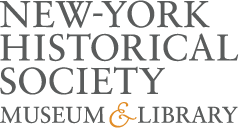
special thanks to Jennifer Nettles, Mihail Lari and Scott Murray, Michele and Steven Pesner and Peace
The New-York Historical Society Museum placed a set of prints from this project into their permanent collection
College Art Association of America – 2023 Annual Conference
Renate Aller presents “side walk” in a panel discussion chaired by Jan Wurm
link: Measuring Time: Pandemic Pursuits and Corona Clocks
side walk 6′ apart in New York City
photo book published by Kehrer Verlag, Heidelberg, Germany

“side walk 6′ apart in NYC”
This project is in the spirit of
Rainer Maria Rilke:
“… that each should stand guard over the solitude of the other”
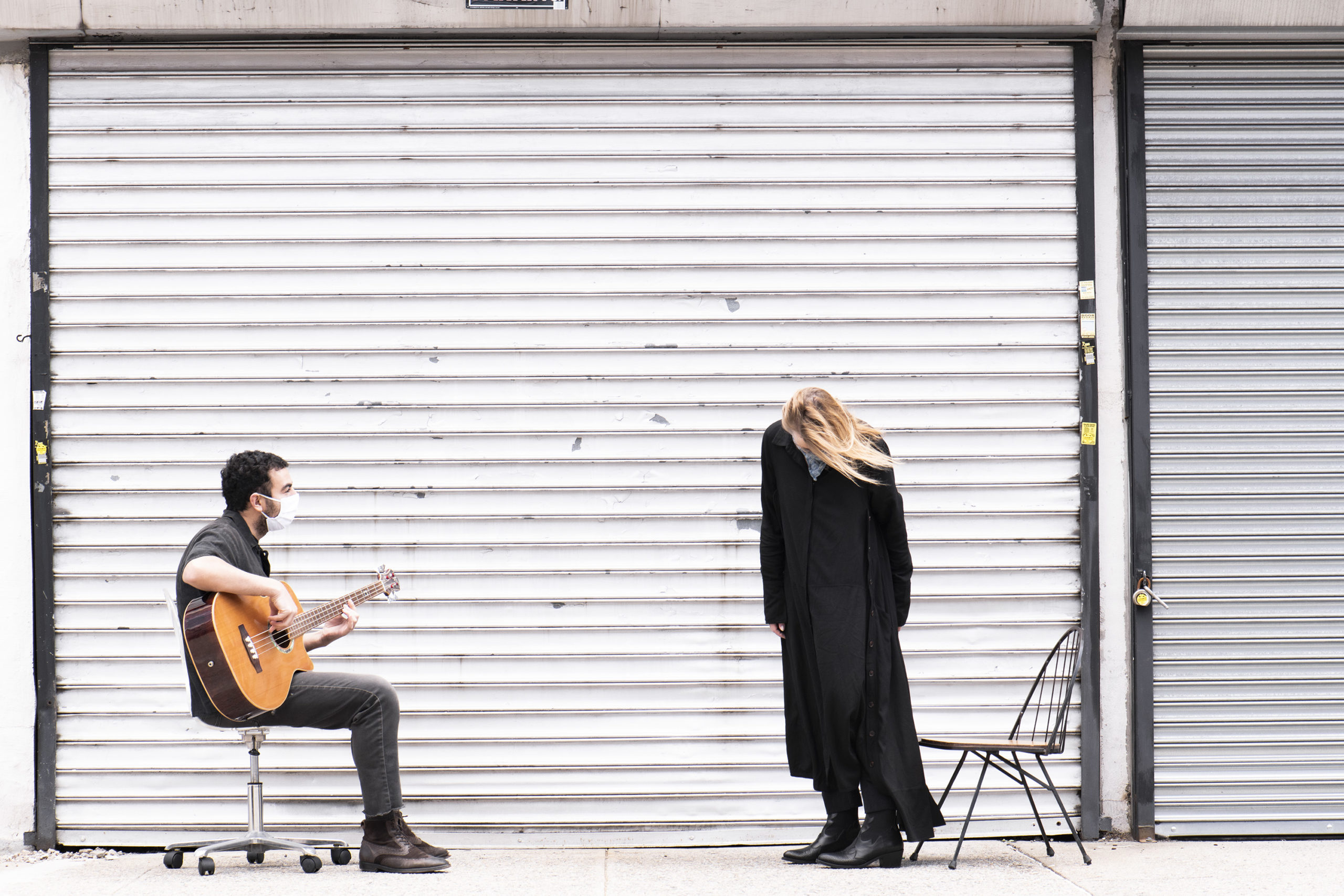
We are all looking at art and life now, more than ever before – through the lens of our times — art in the time of Covid-19 and our current socio political awareness heightened by the recent events surrounding the murder of George Floyd and many others.
I created the project ” side walk” with my camera during the lockdown period when NYC was the epicentre of the pandemic.
This time in history reminds me of the period right after 9/11. I took images of interiors as the drama was one of the exterior, the monumentality of this city was attacked and therefore I pointed the lens into the private spaces.
We were all afraid for our own safety then. Today we are feeling pain and are more afraid for others.
As a reaction to people’s lives in solitude ….. For most of April and May I hosted friends and neighbors on our sidewalk or visited them in their street – from a safe 6’ distance, with face masks, the camera in self timer mode recording these encounters.
These sidewalk visits give us a deep sense of community where community has been forced apart.
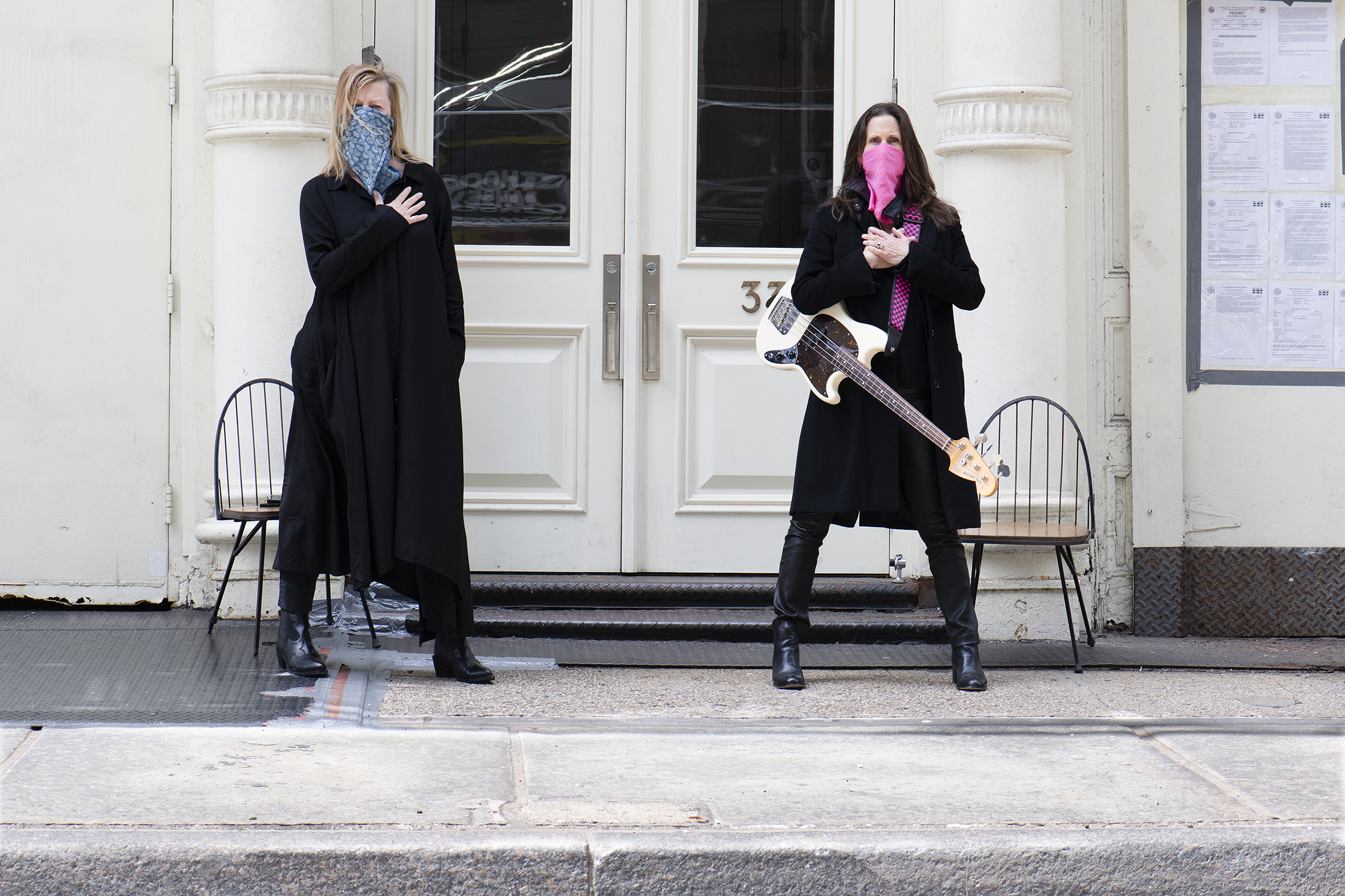
guardians of peoples’ hopes
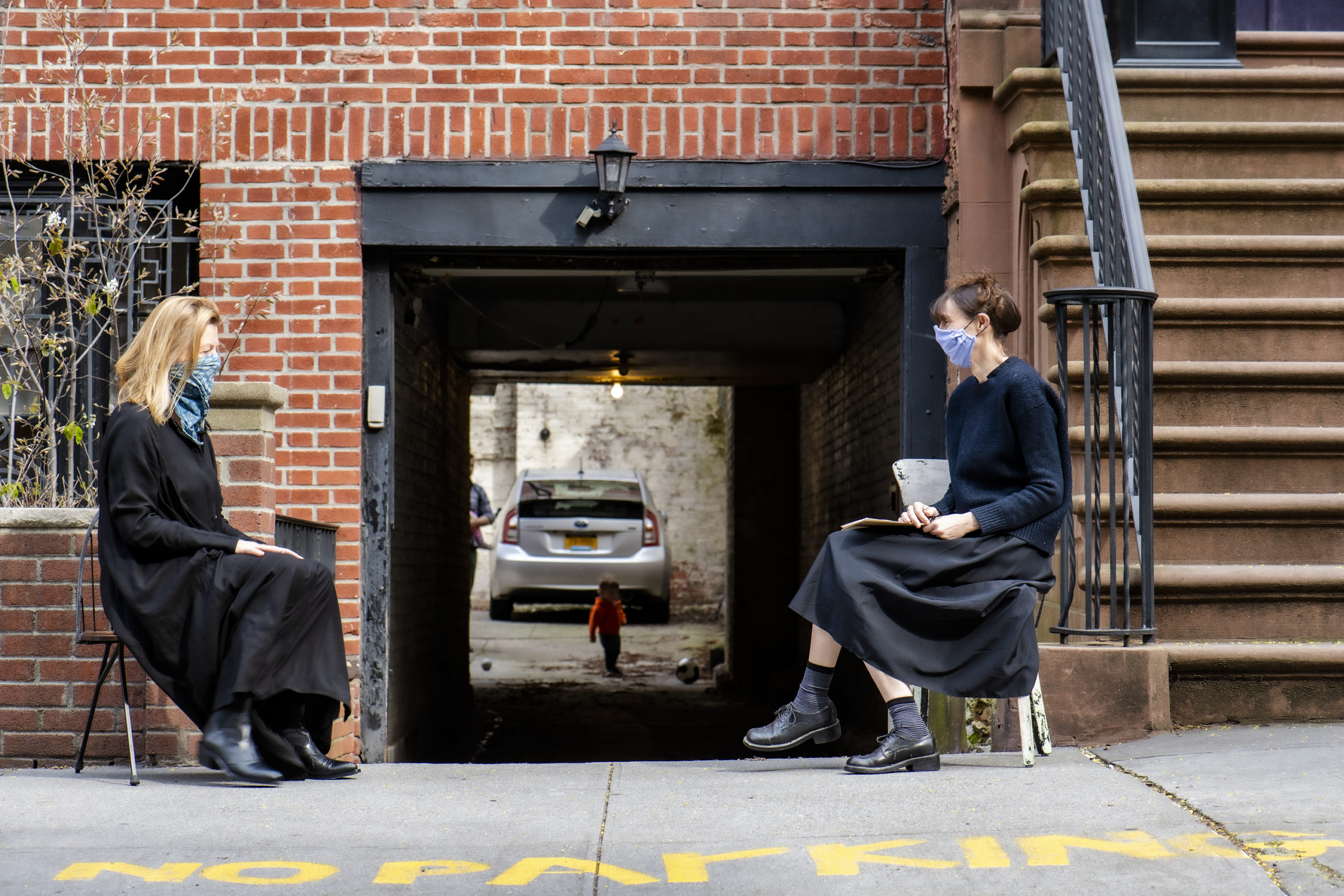

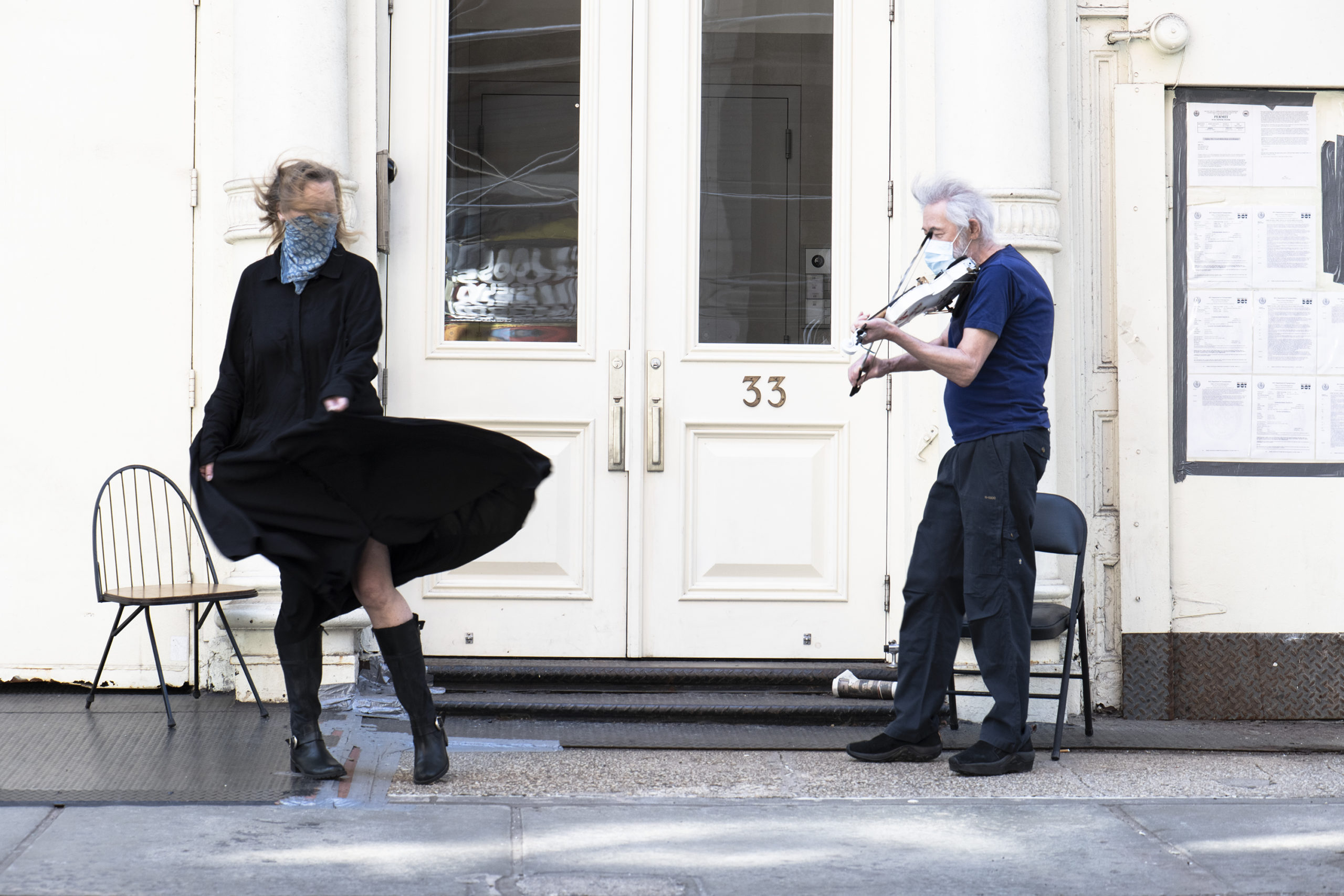
creating a sense of community where community has been forced apart
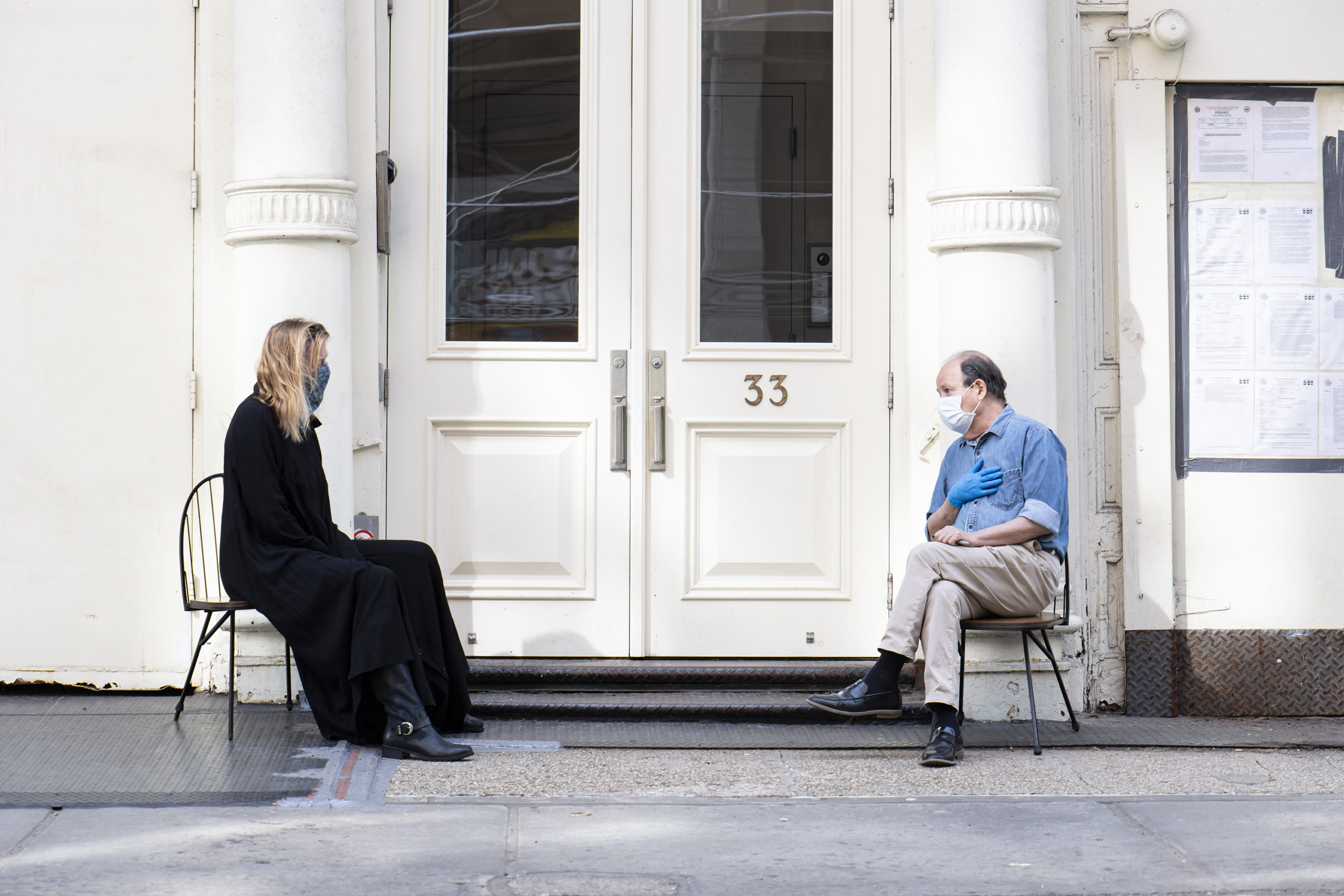
muted voices behind masks
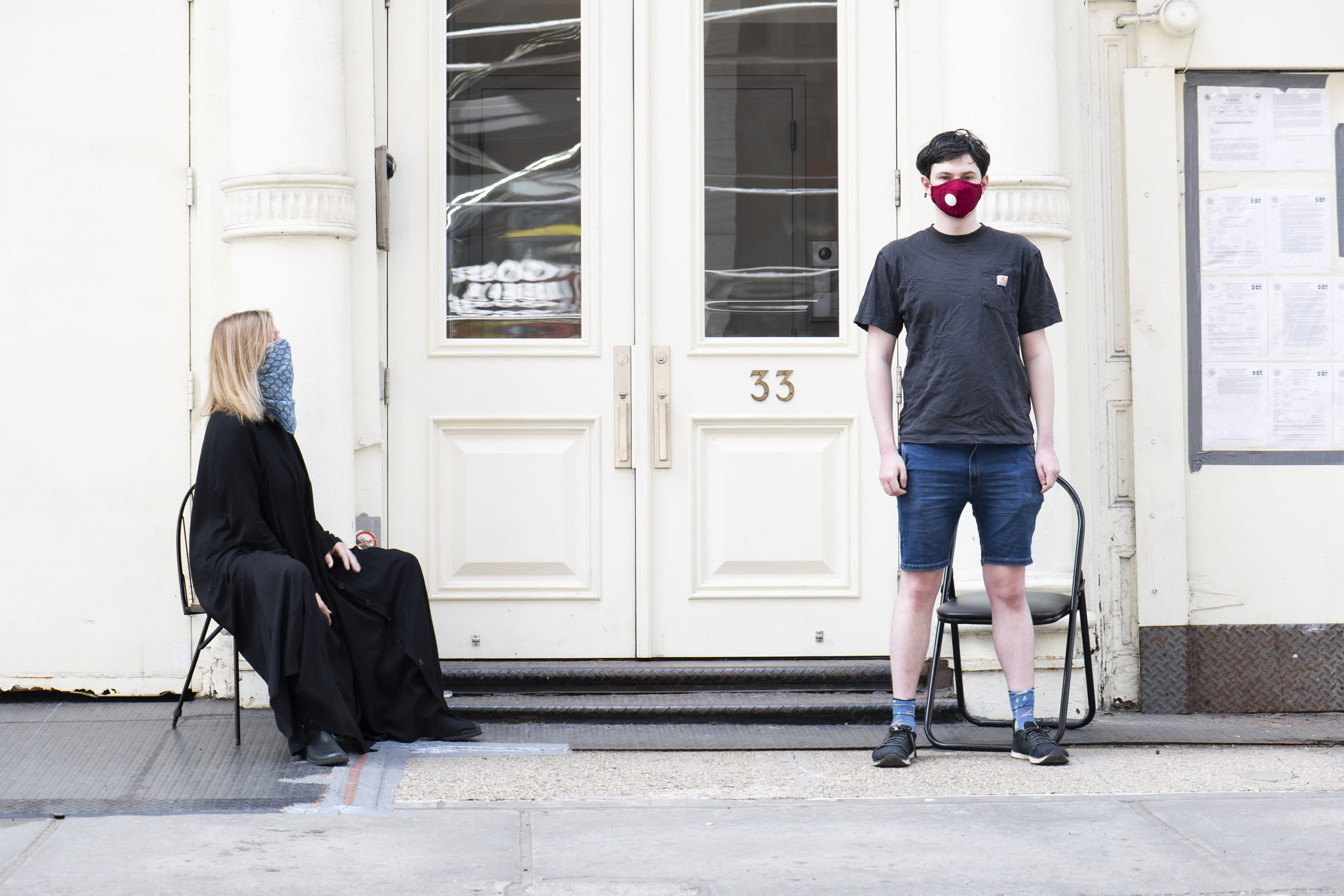

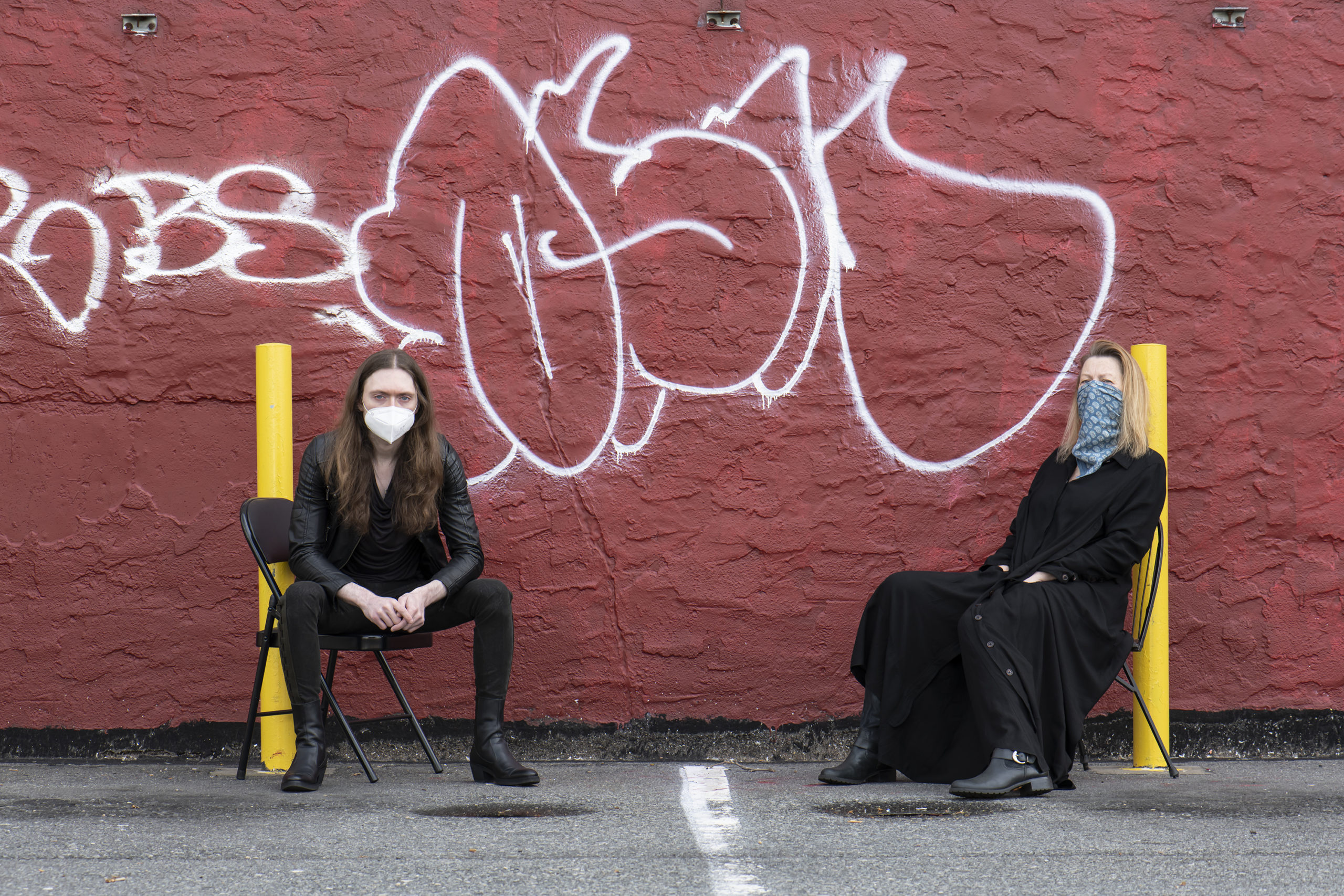
In solitude we try to create an autonomy from overwhelming emotions
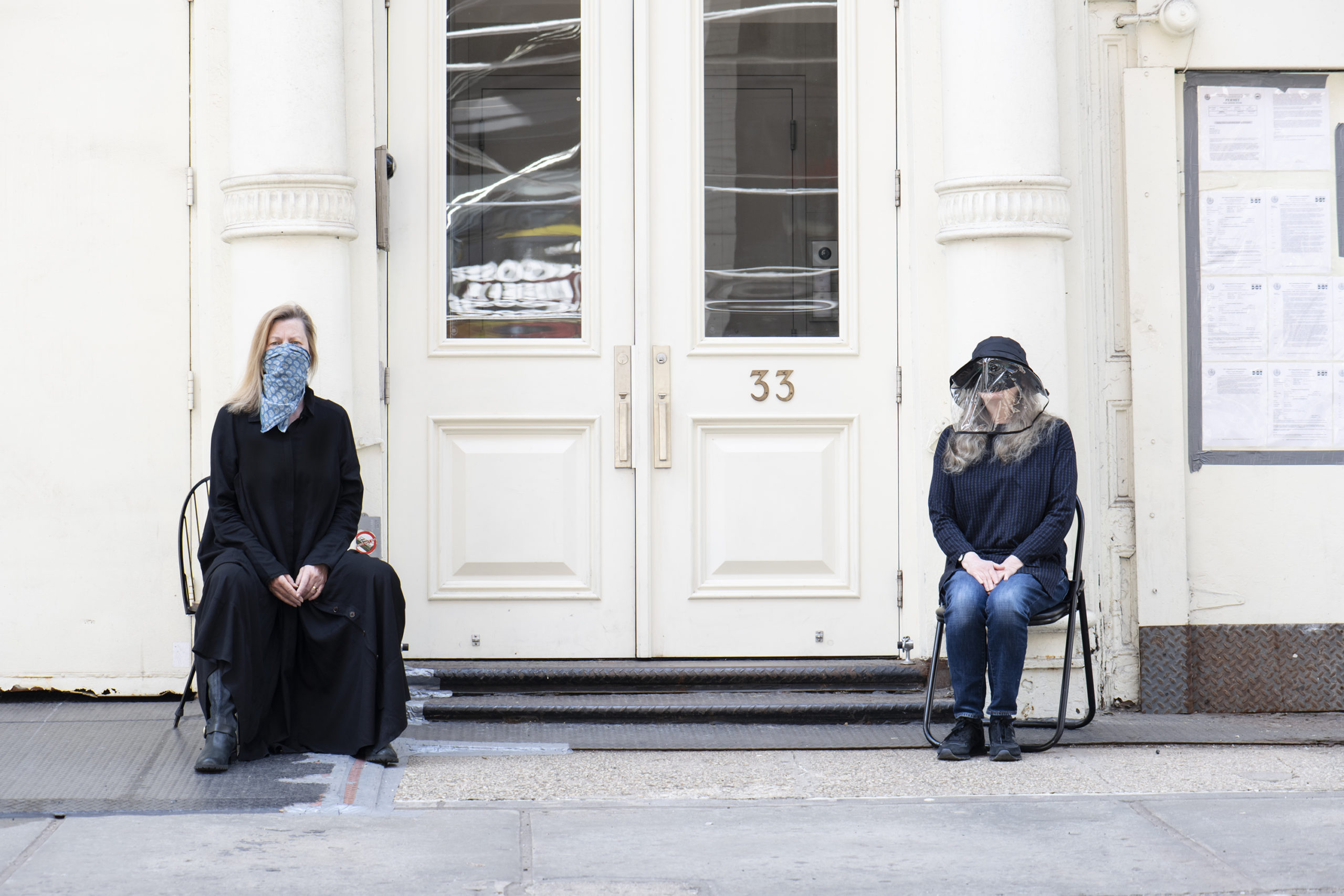
together
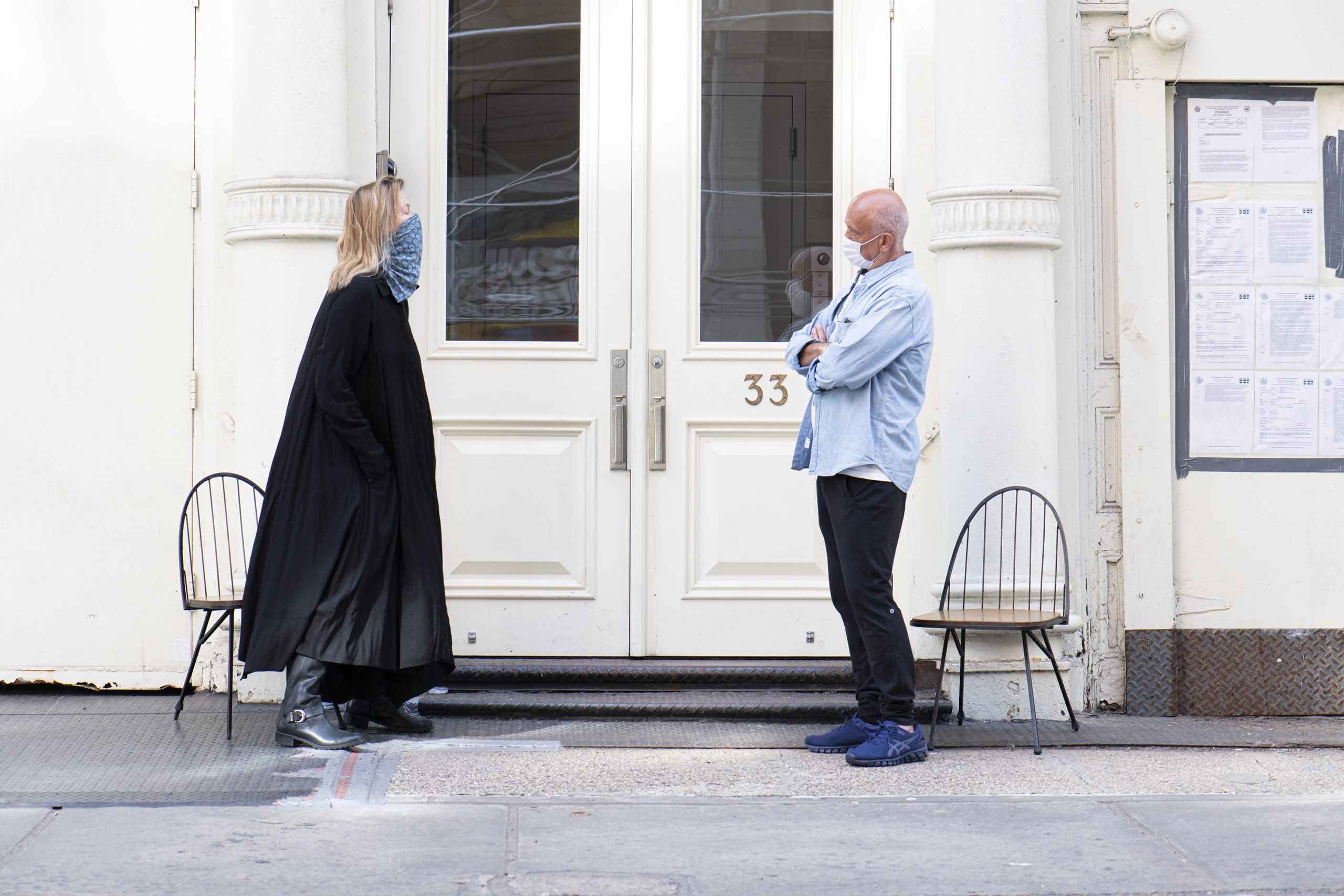
we are listening to each other’s heartbeats
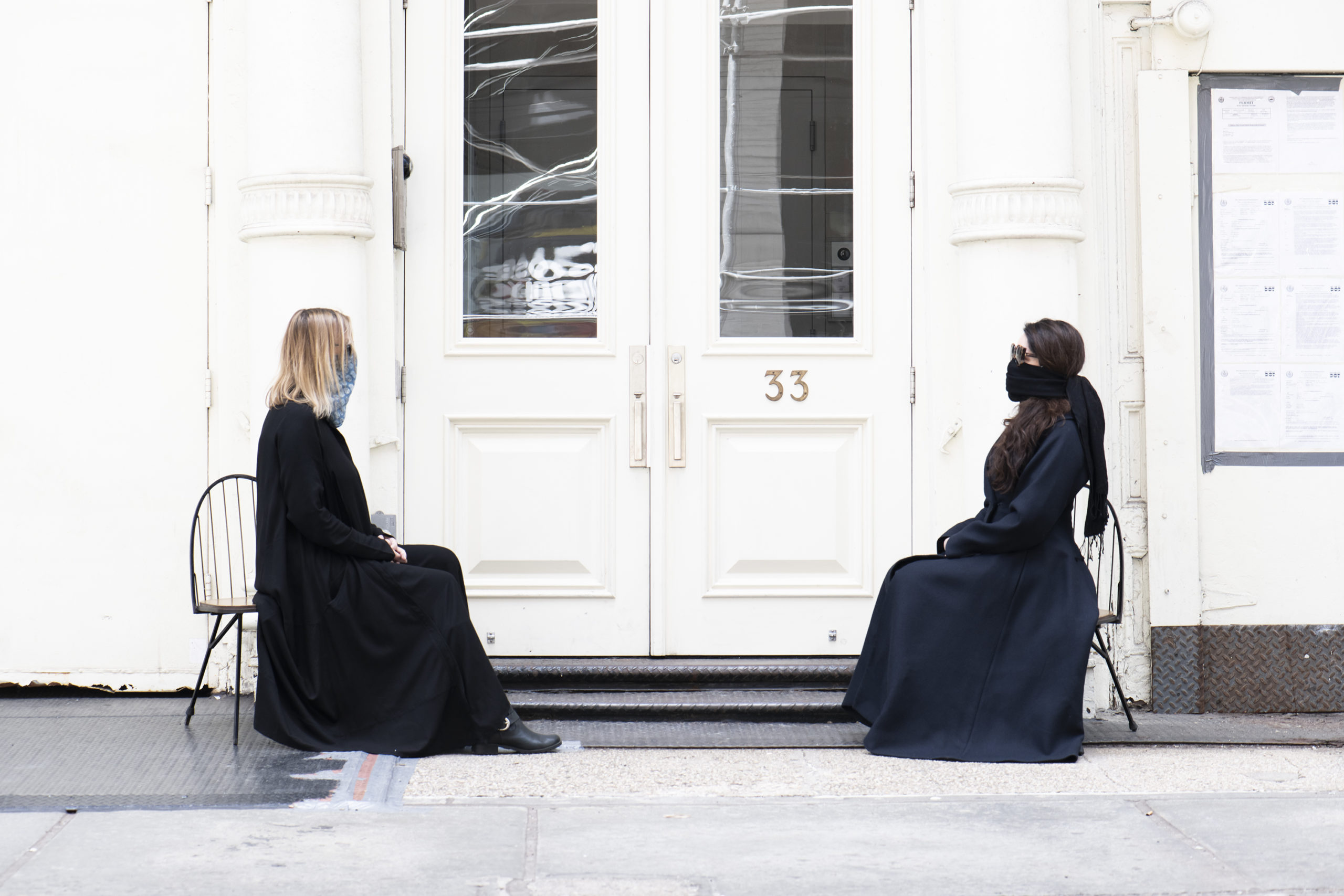
the city’s silence is calming and numbing
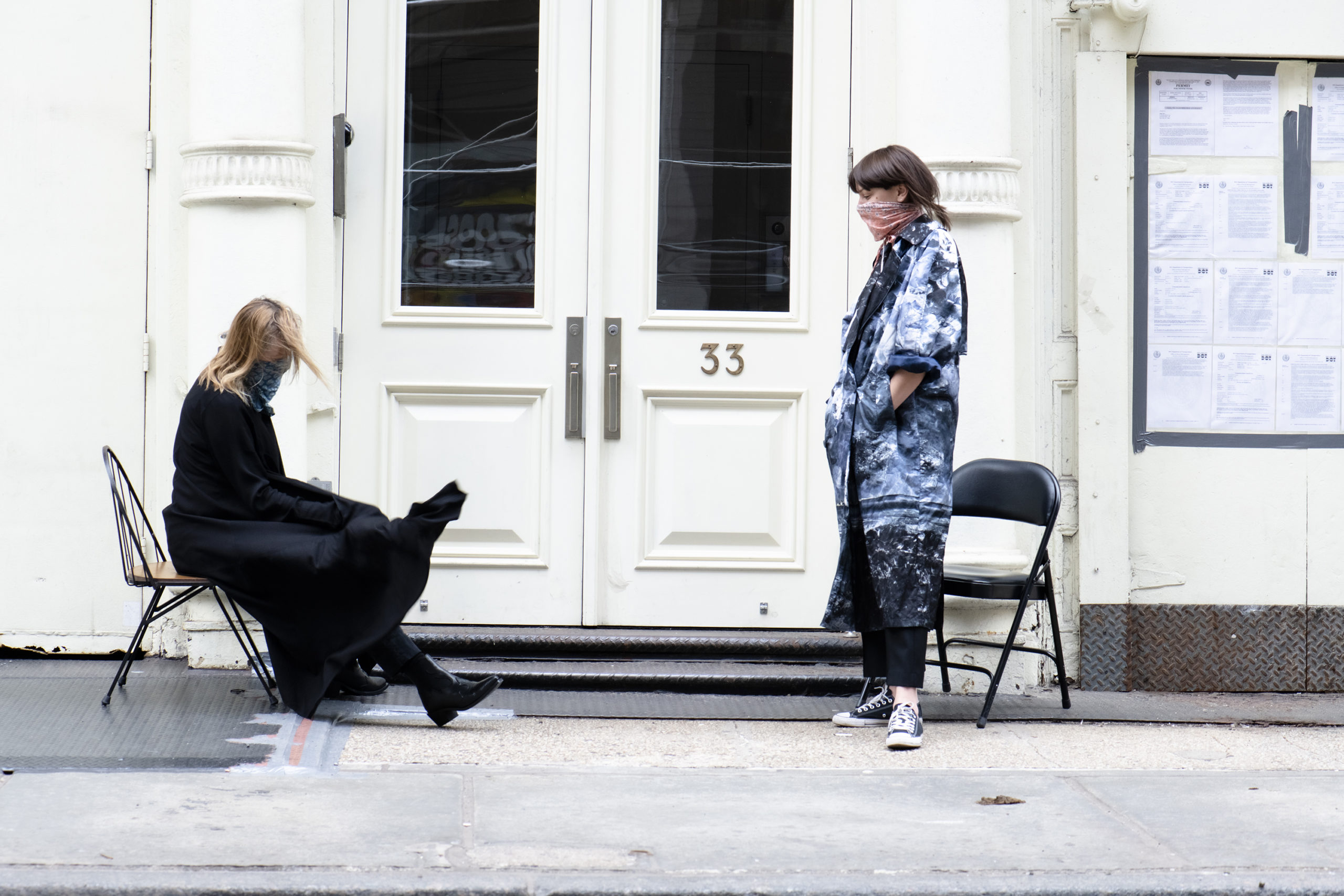
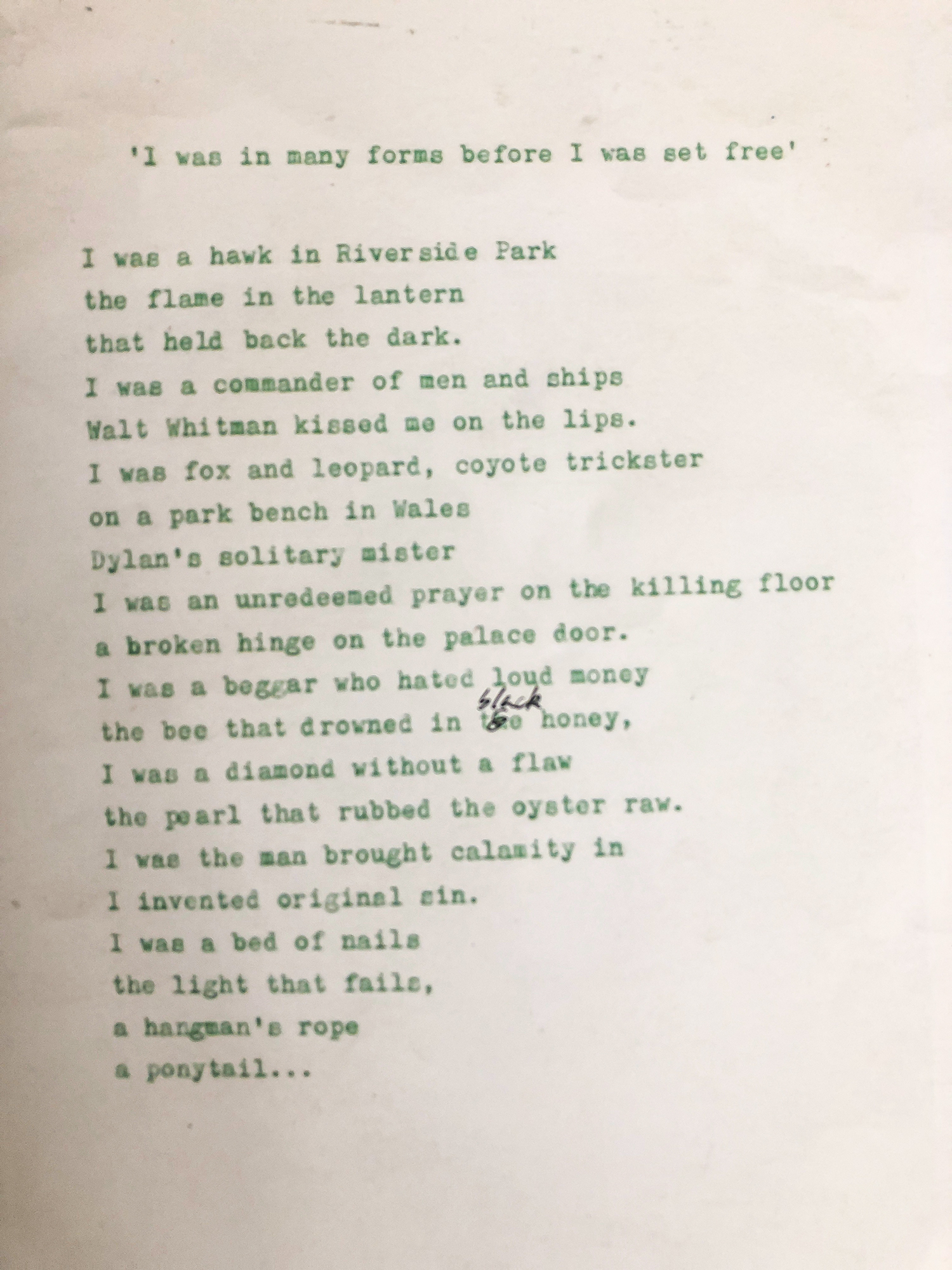
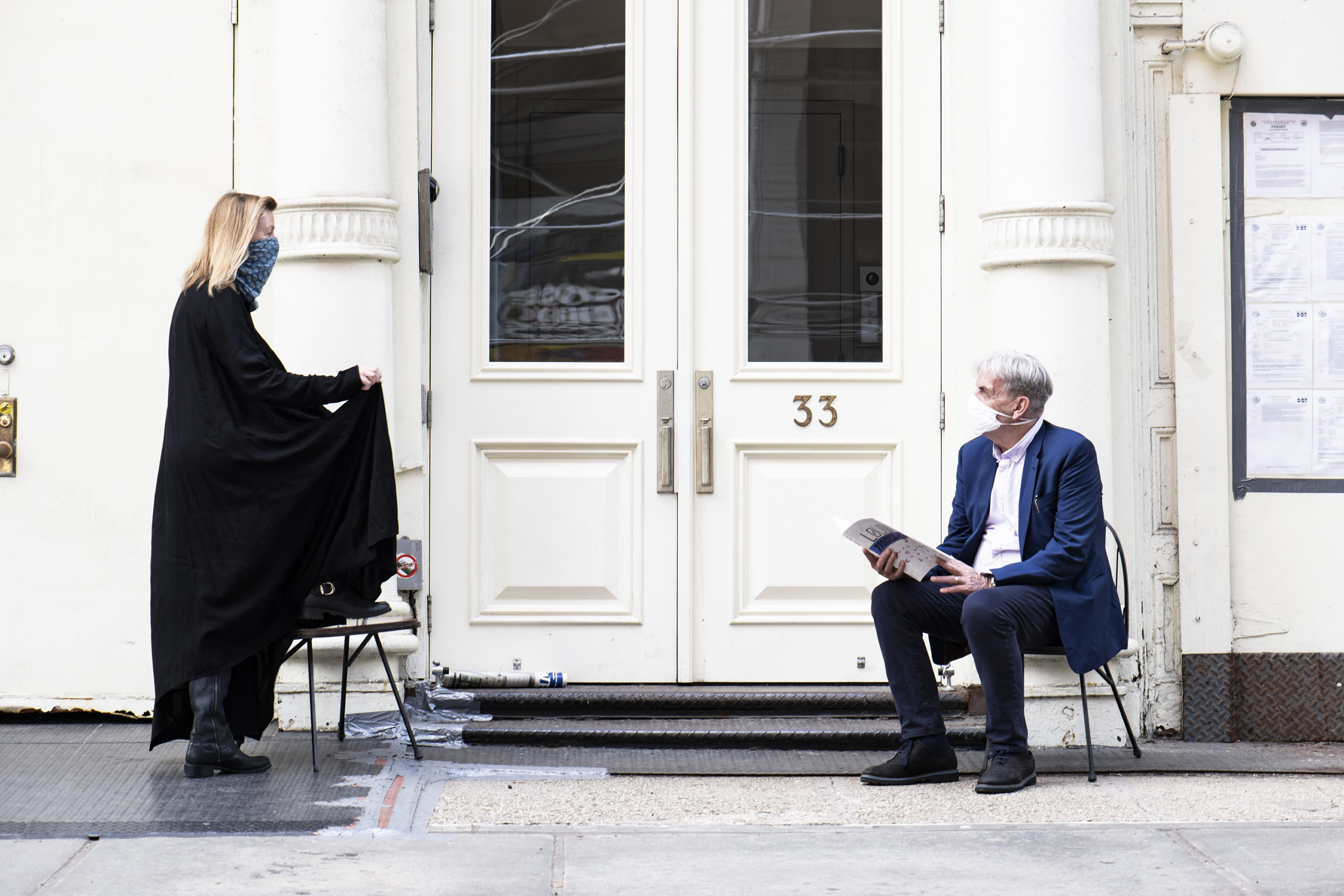

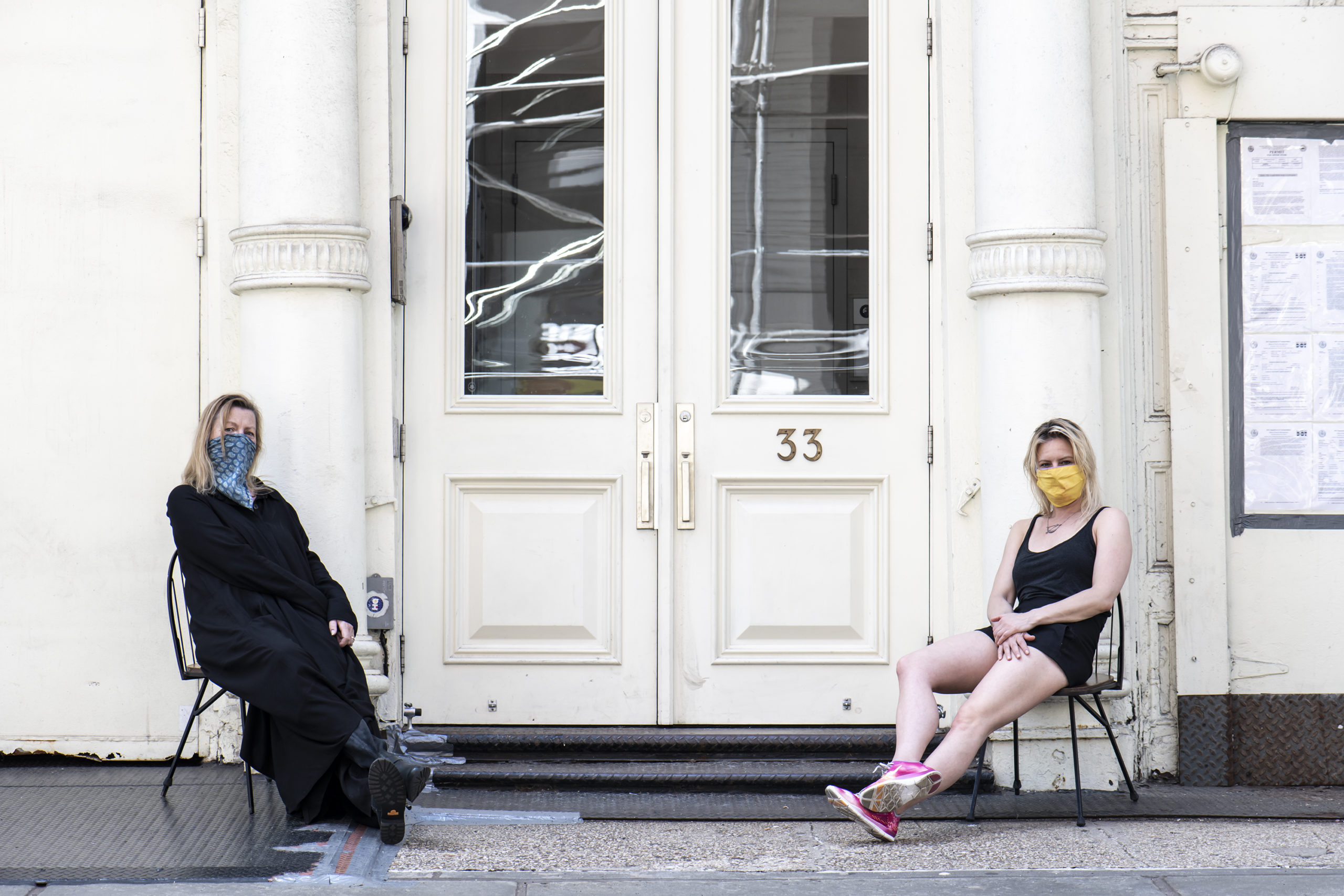
from moment to moment

respond to the other rather than react
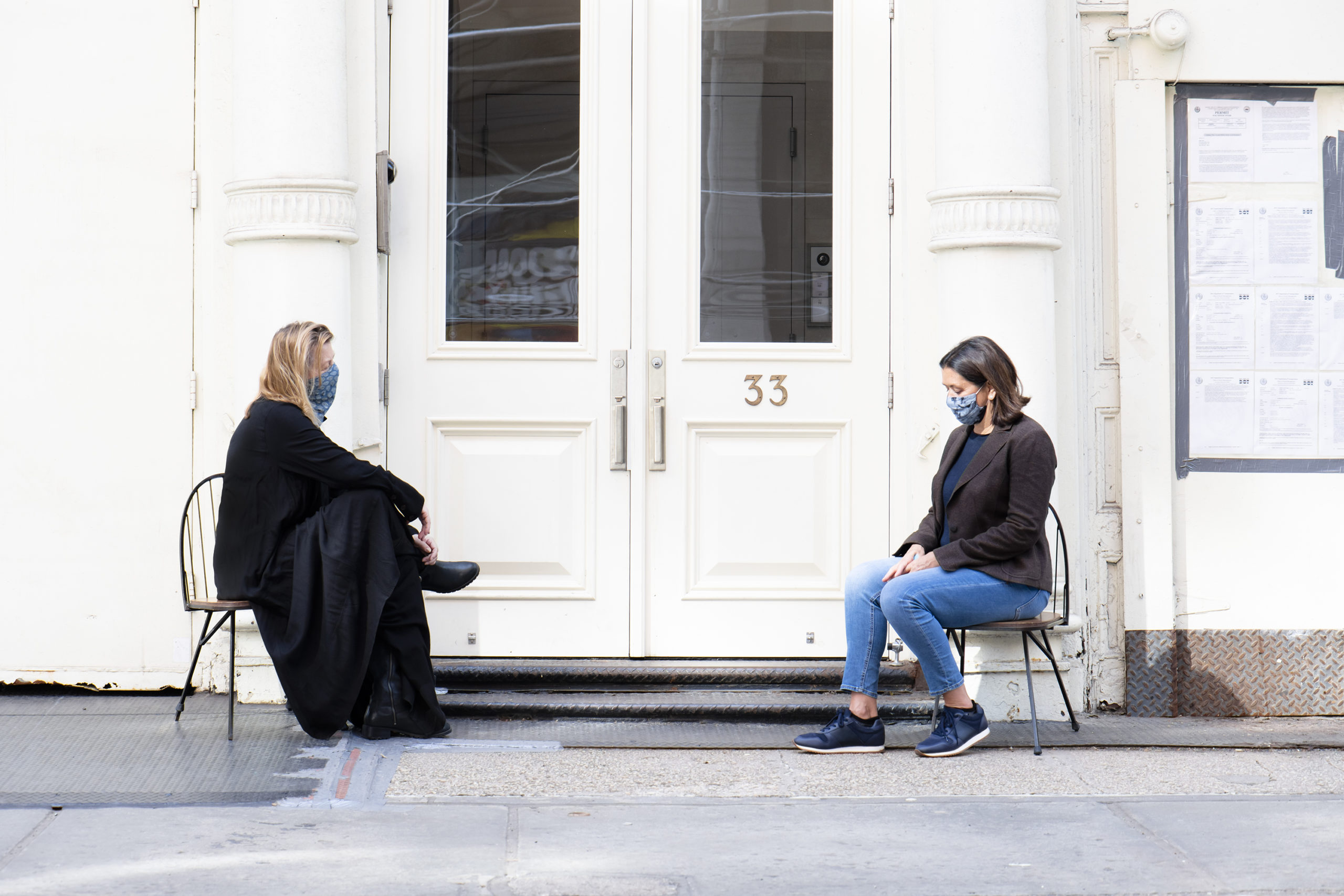
Einsamkeit – living with solitude
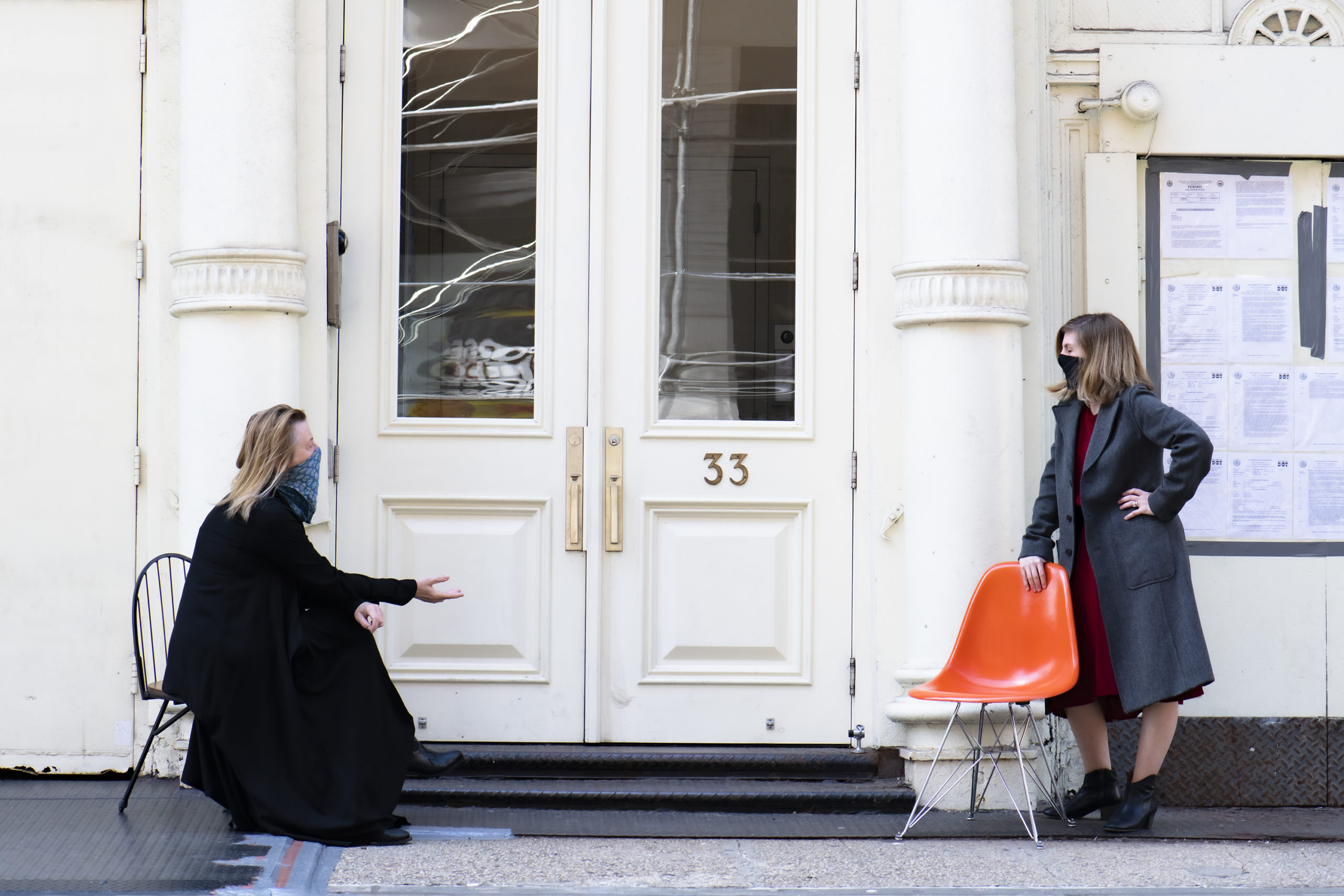

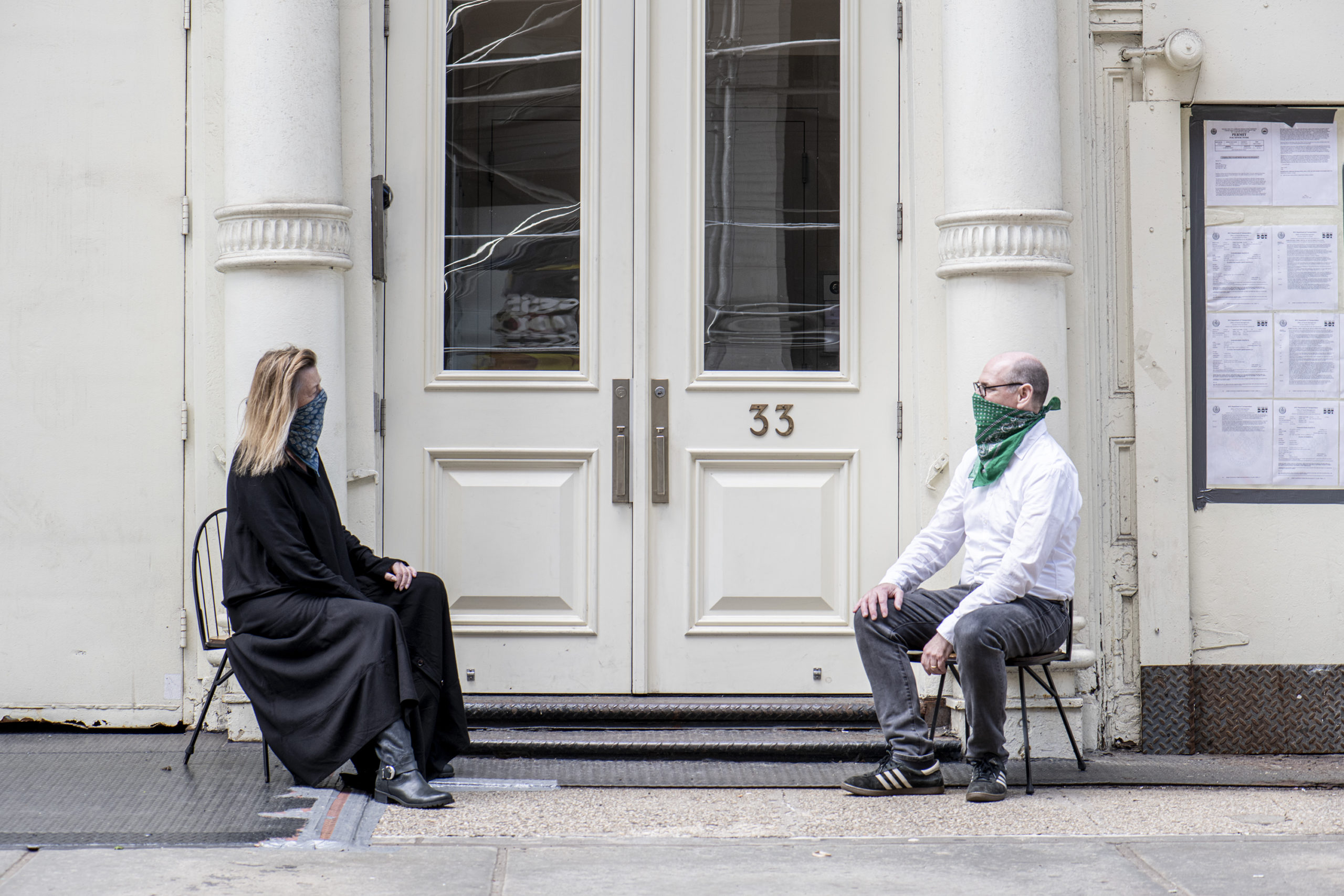
staying in one place, not moving
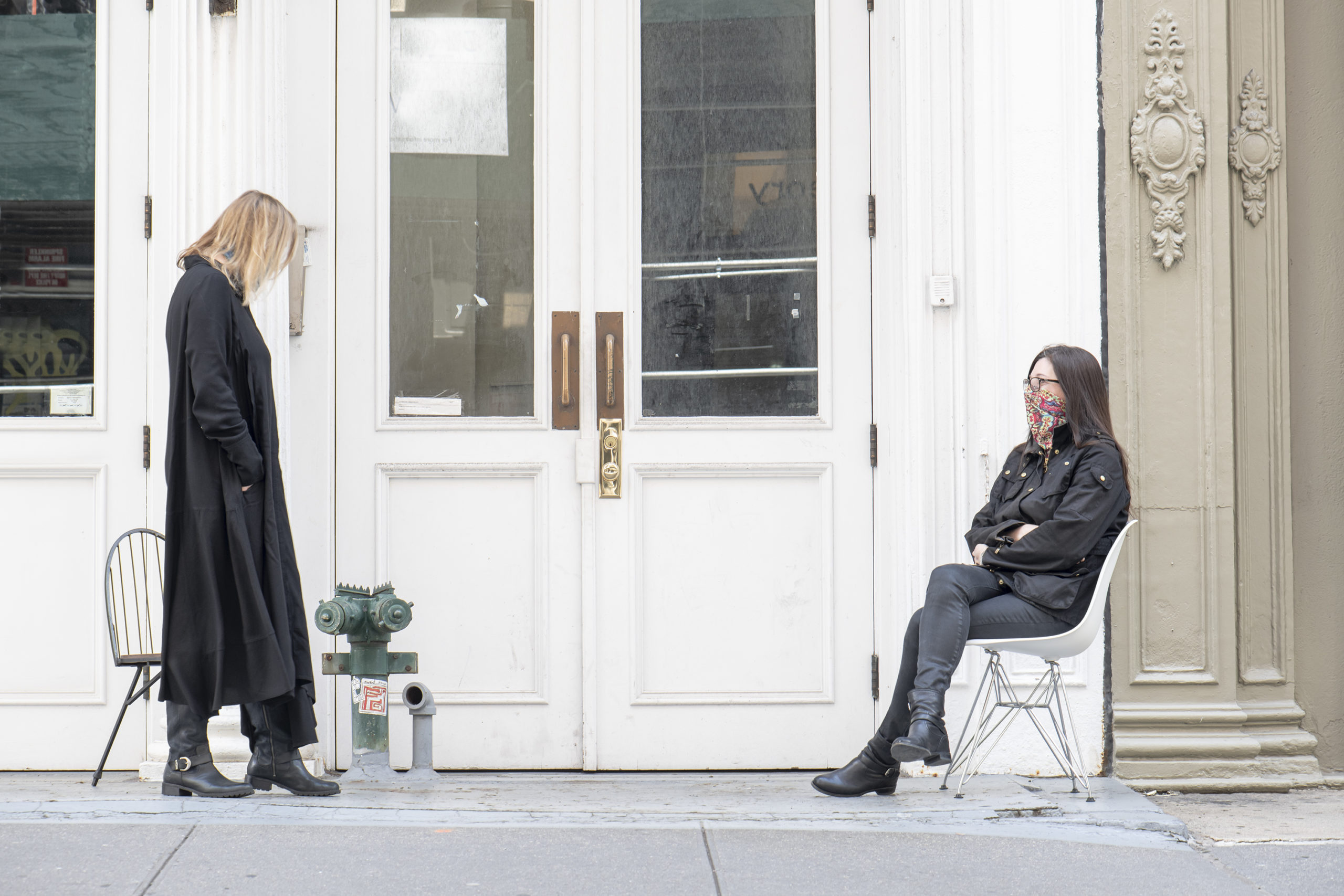

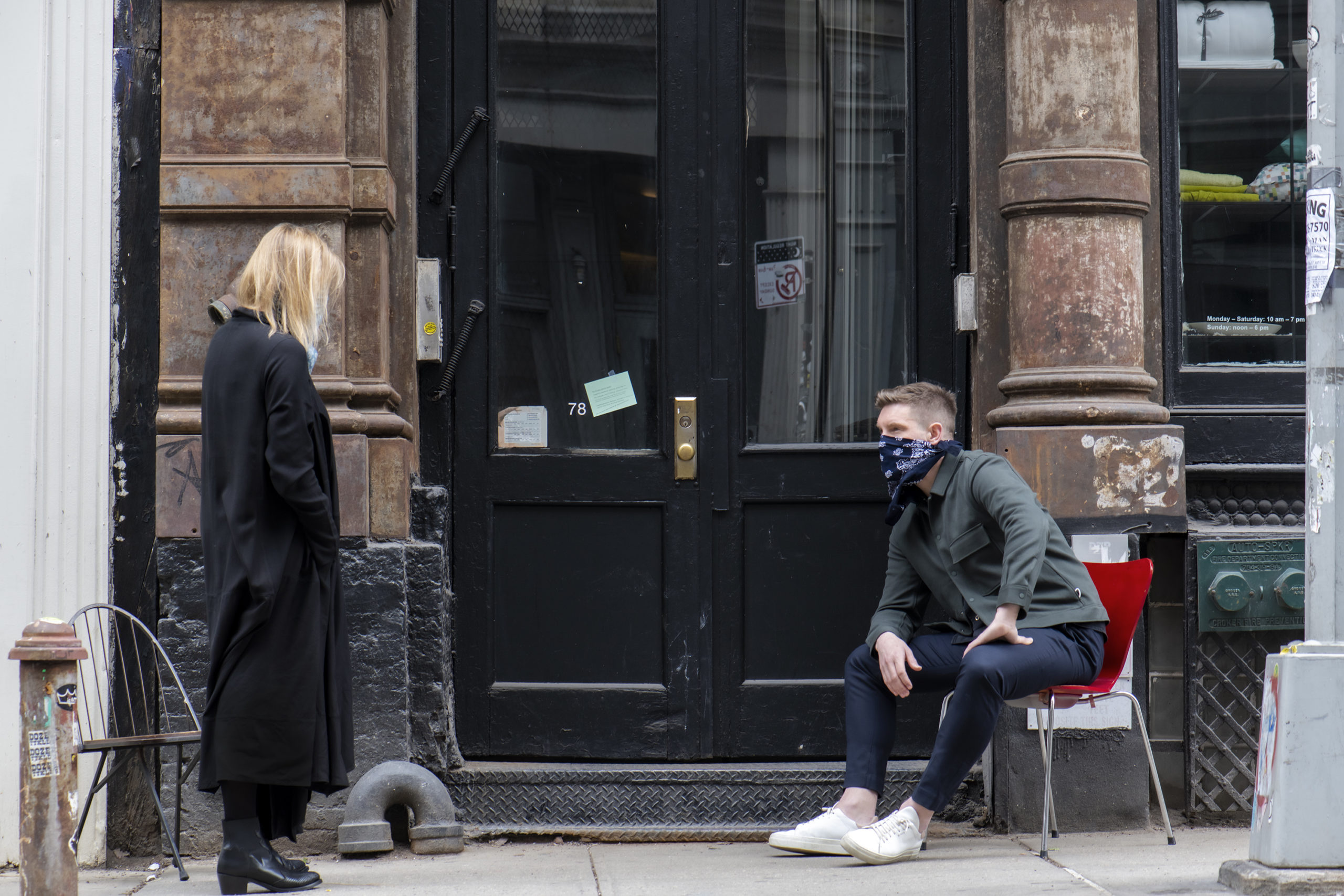

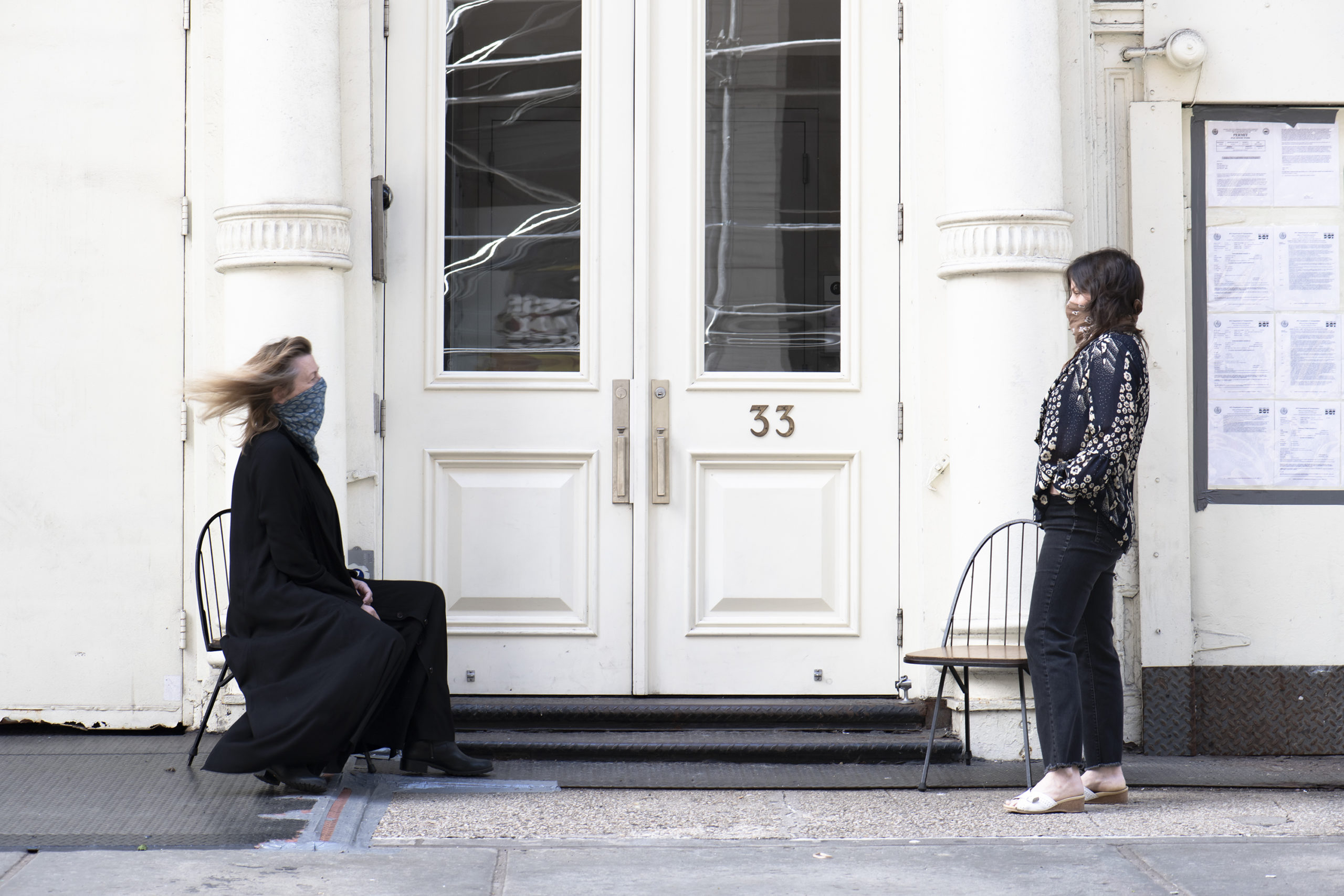
courage
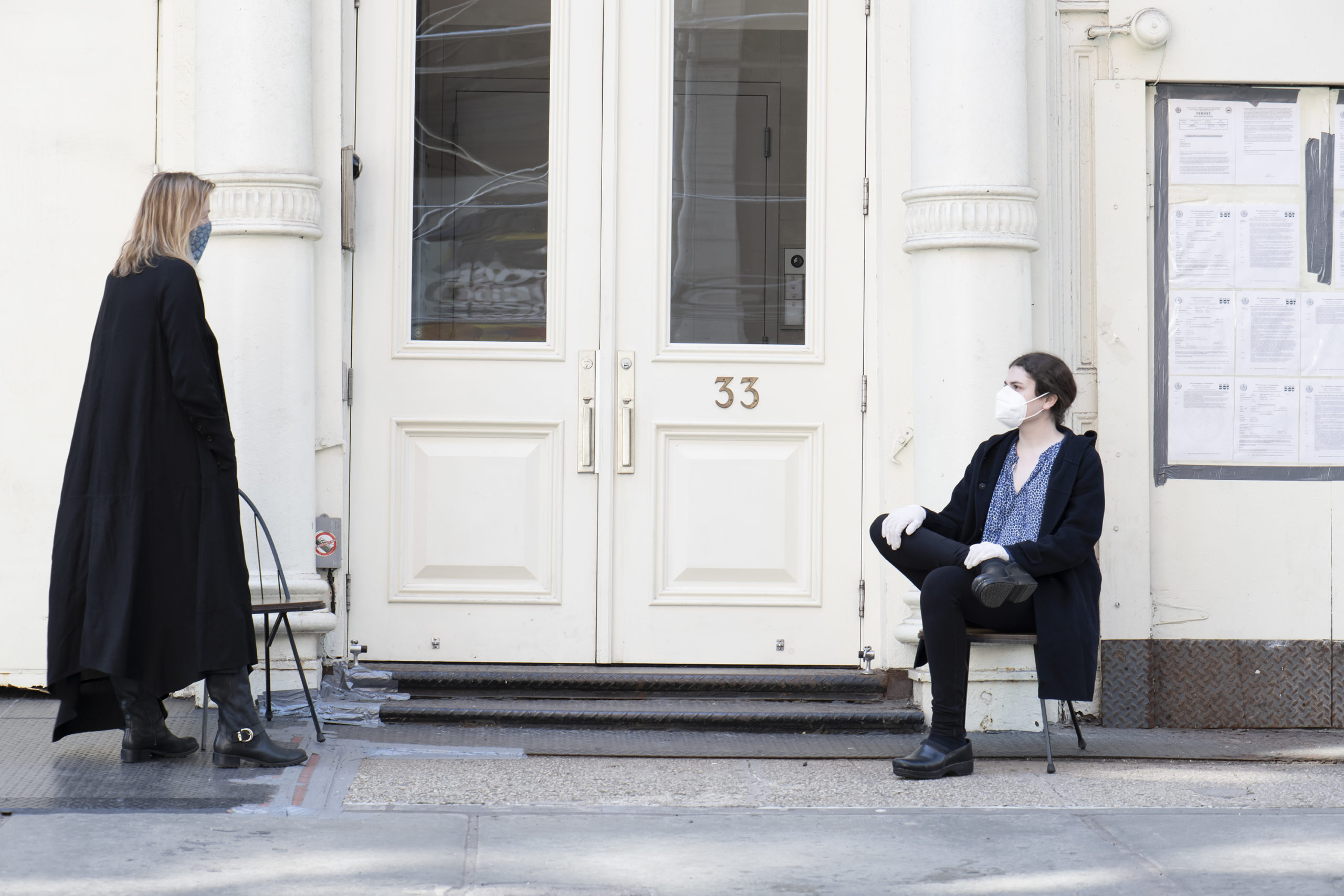

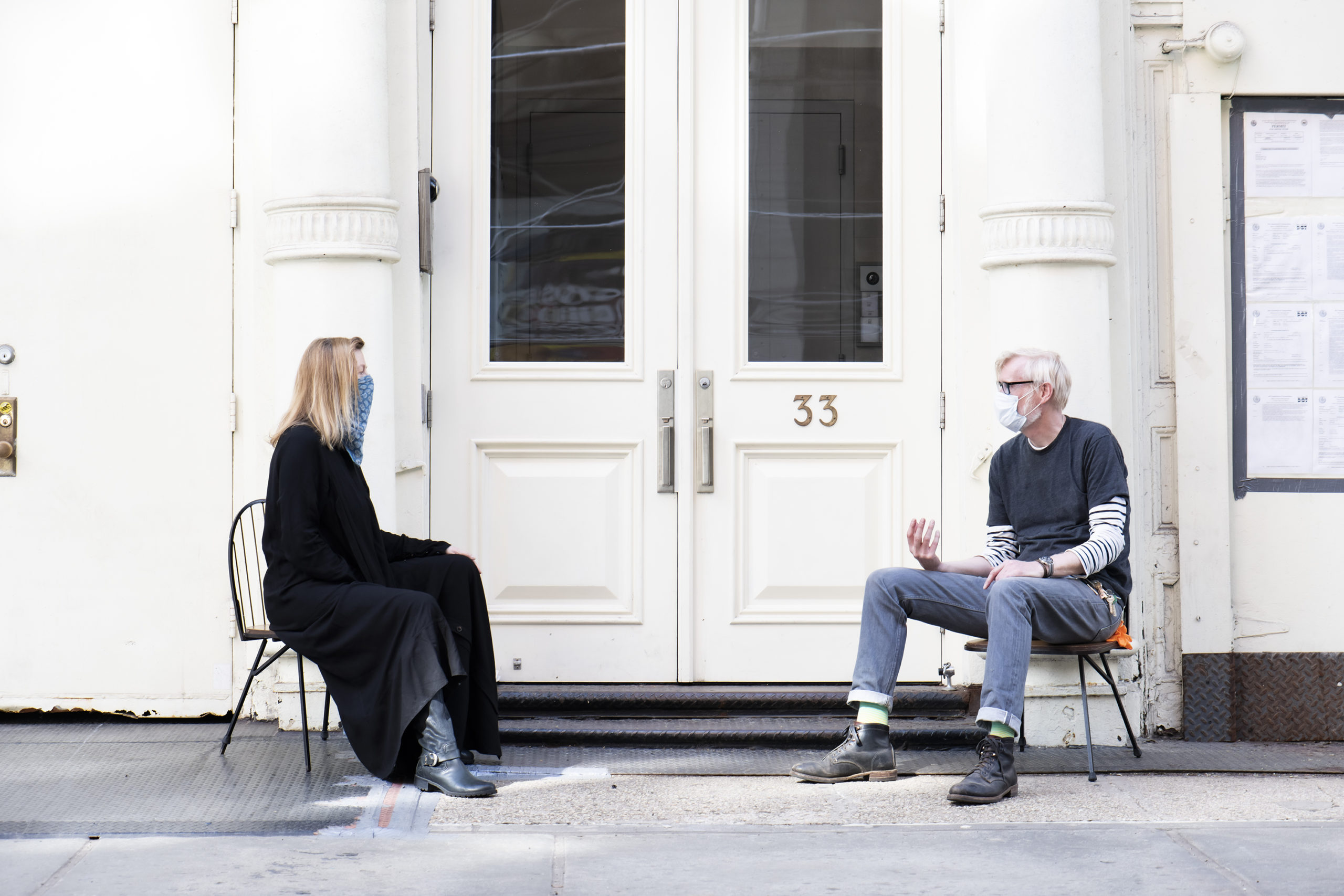
non-static listening
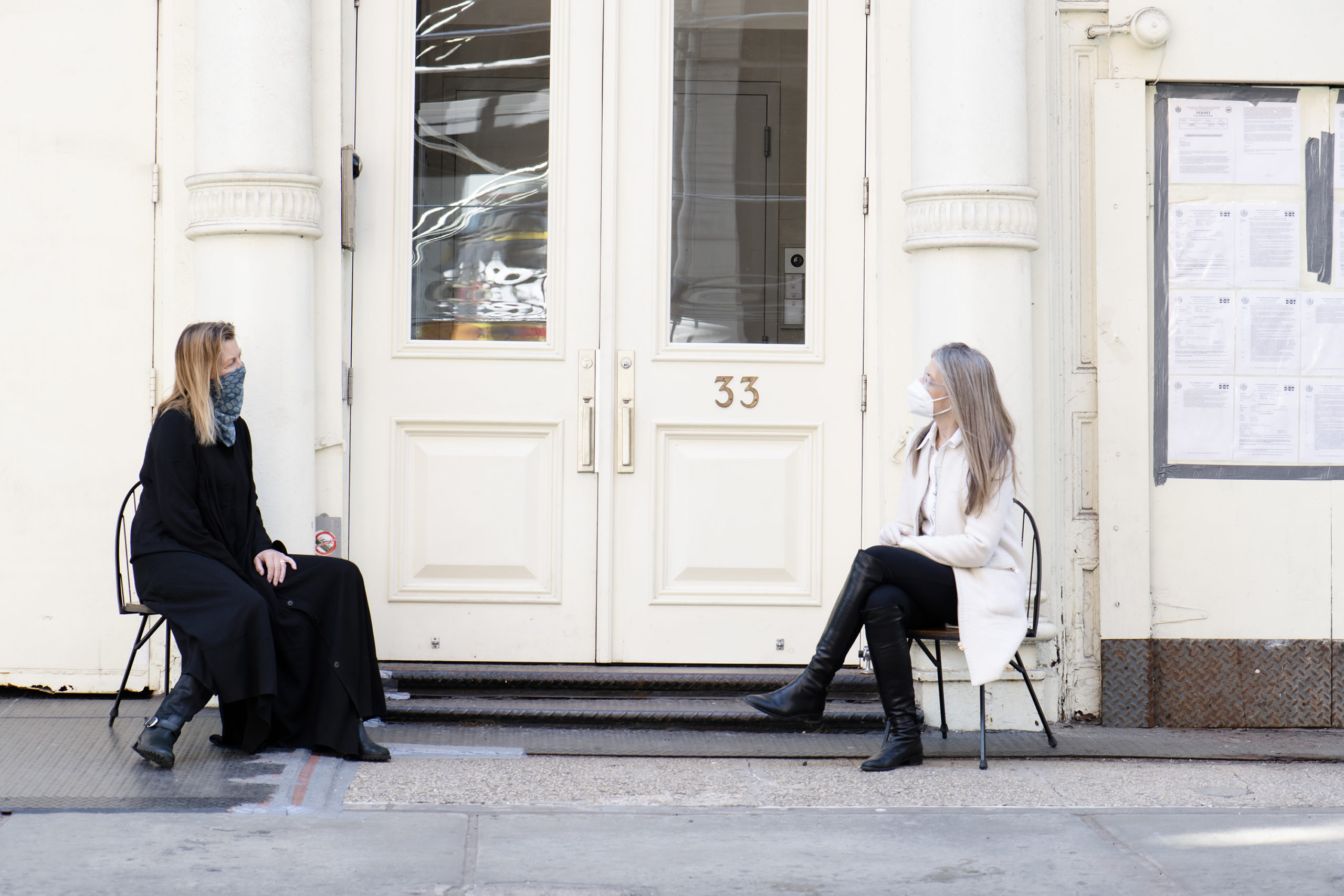
we are in a transitional world and the images of reality appear to us as an abstraction
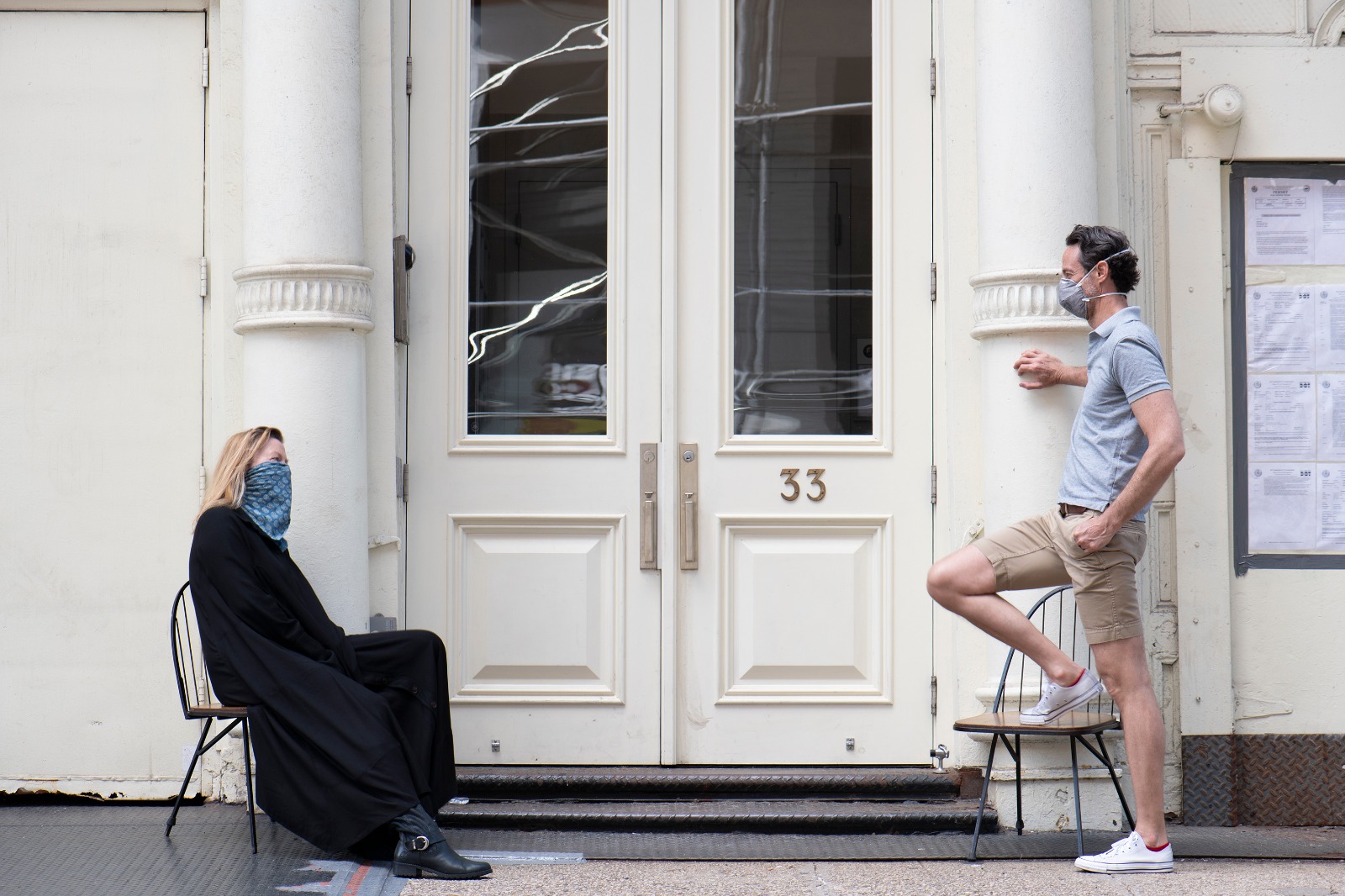

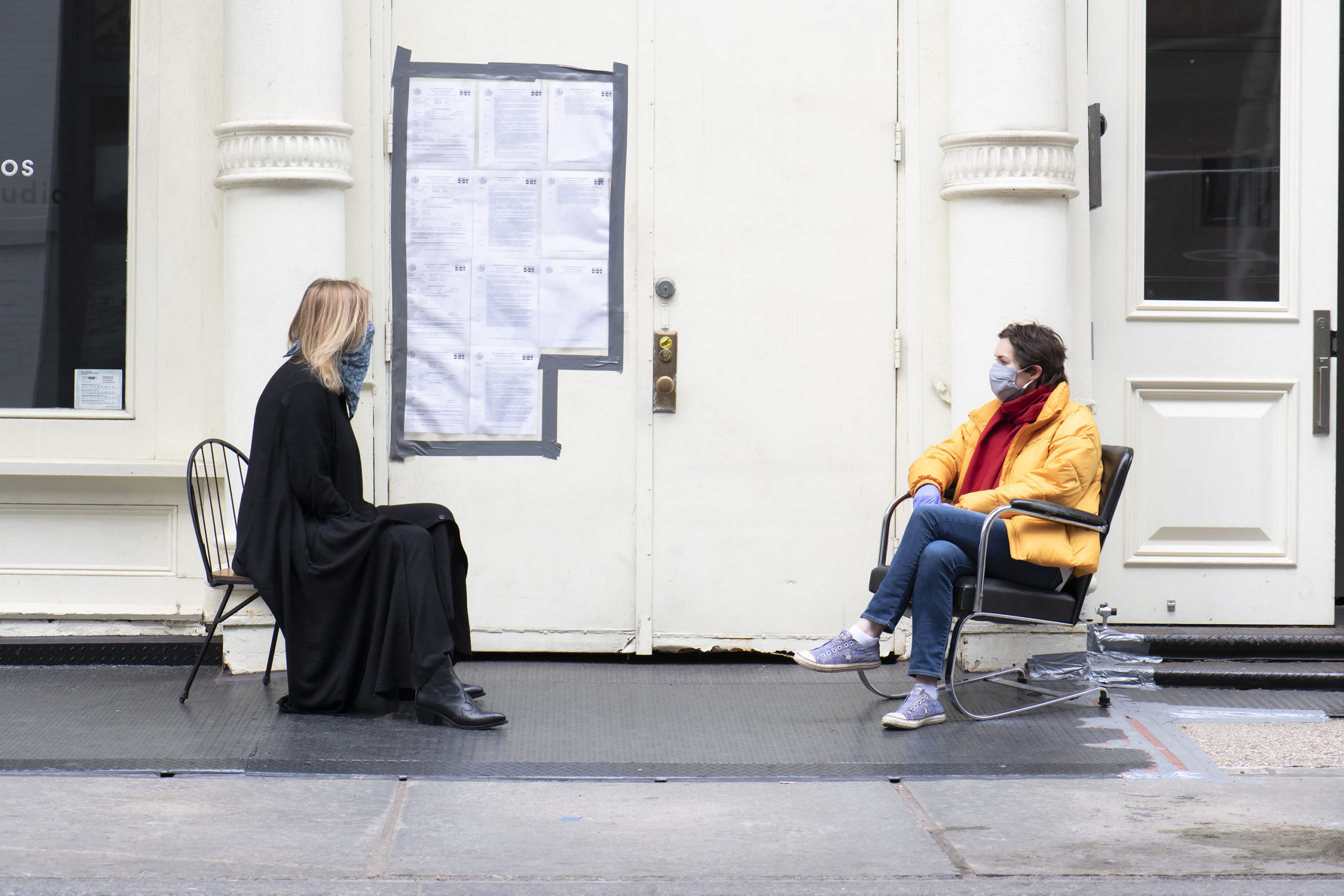
filling the space between


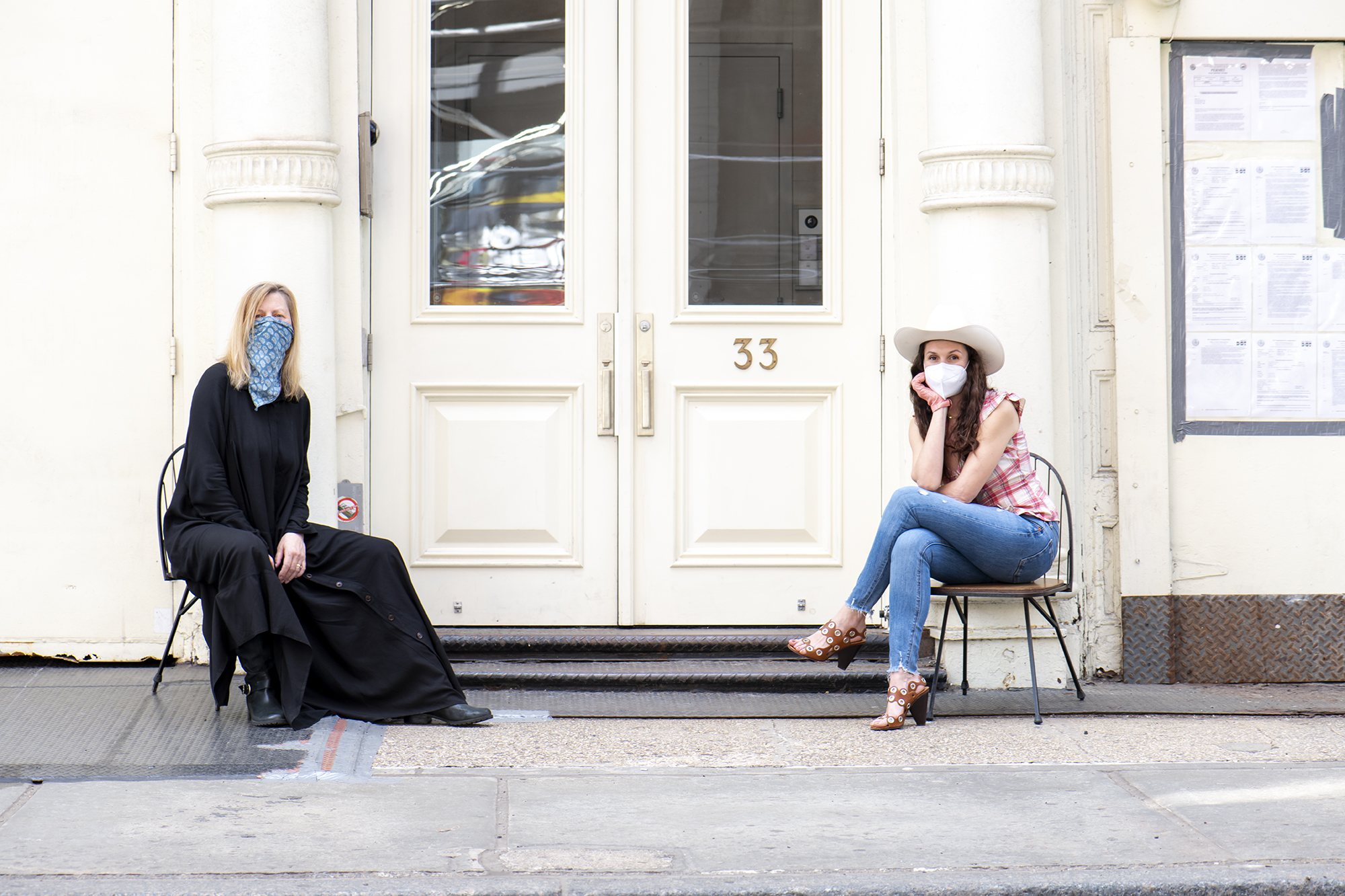
promise
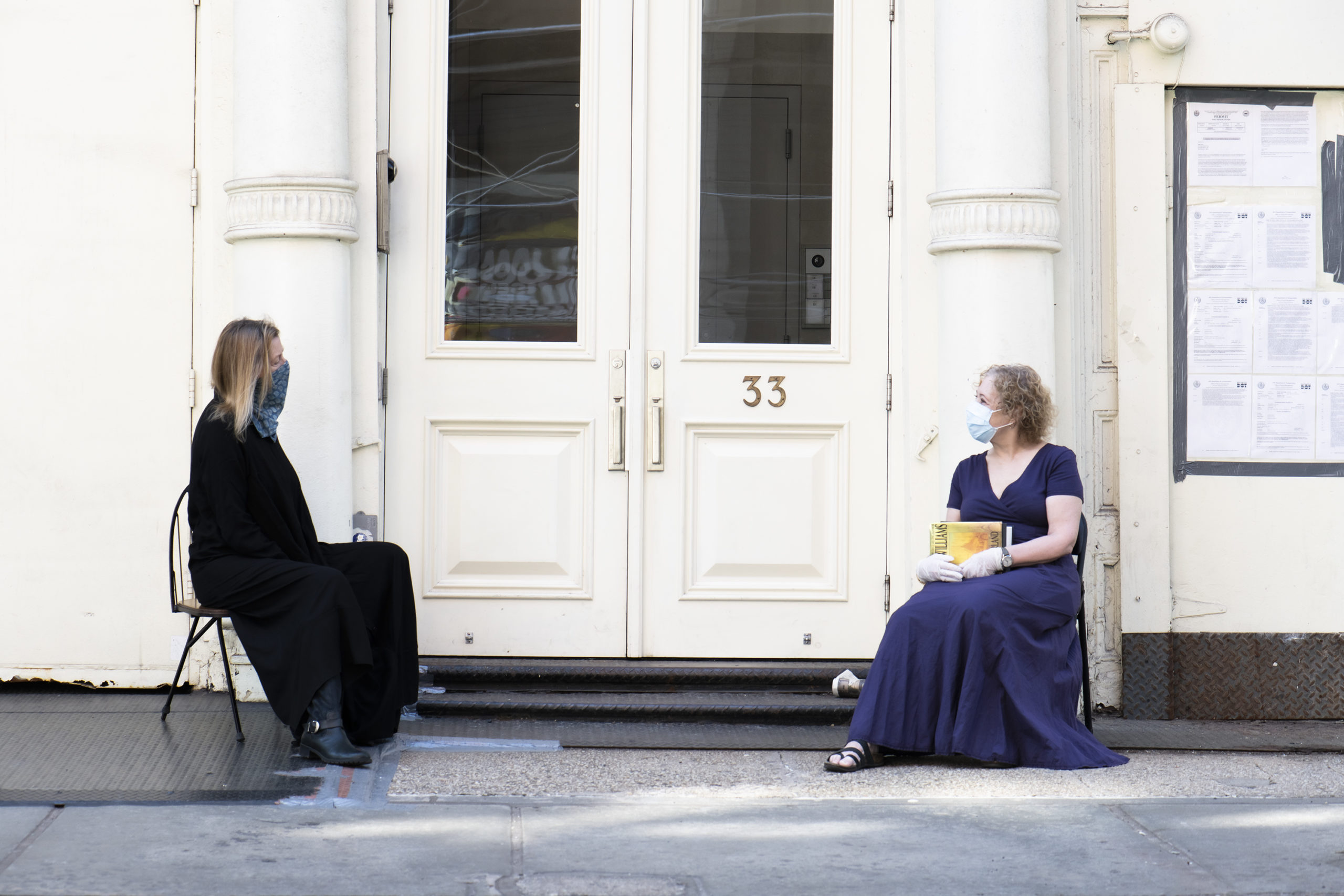

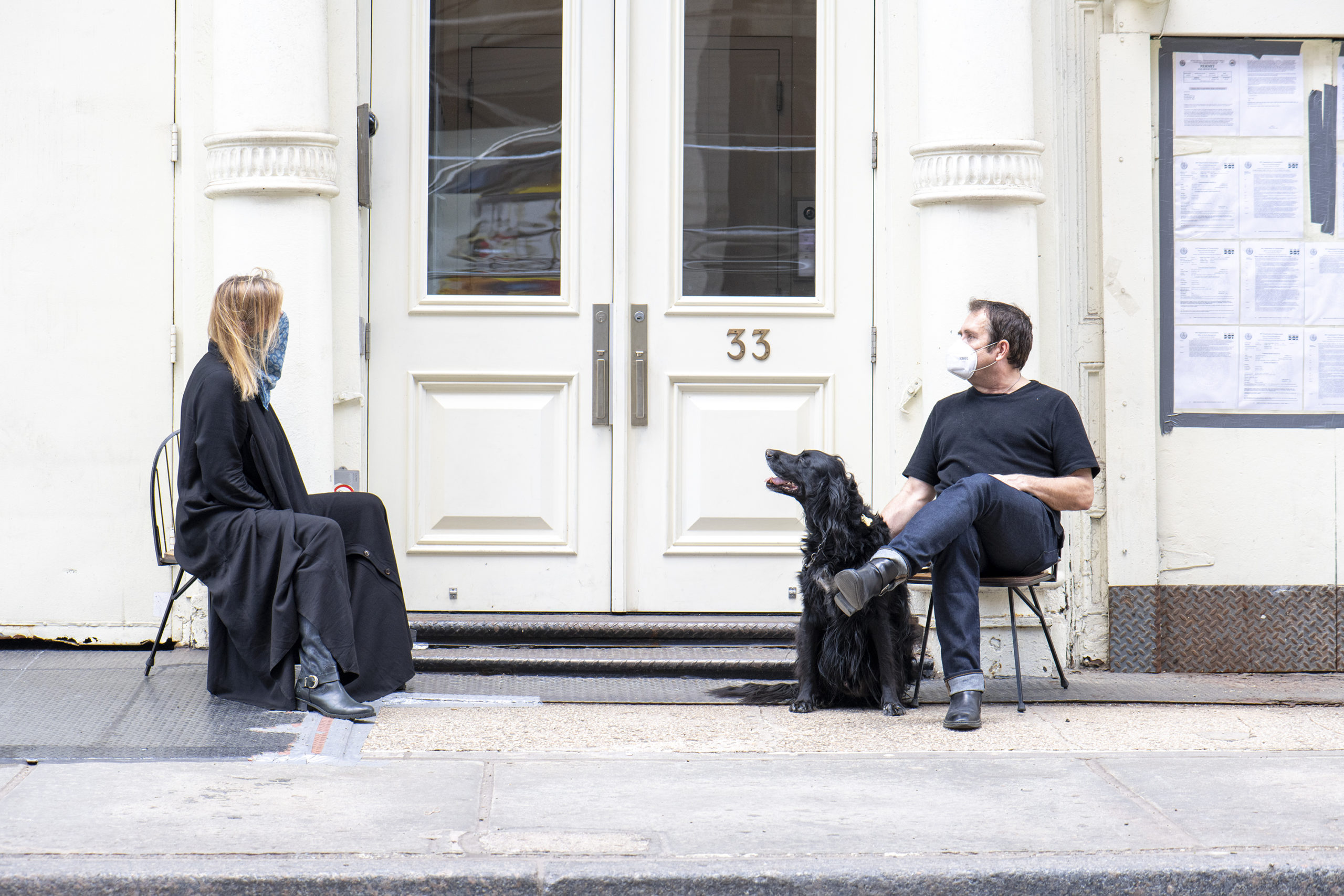

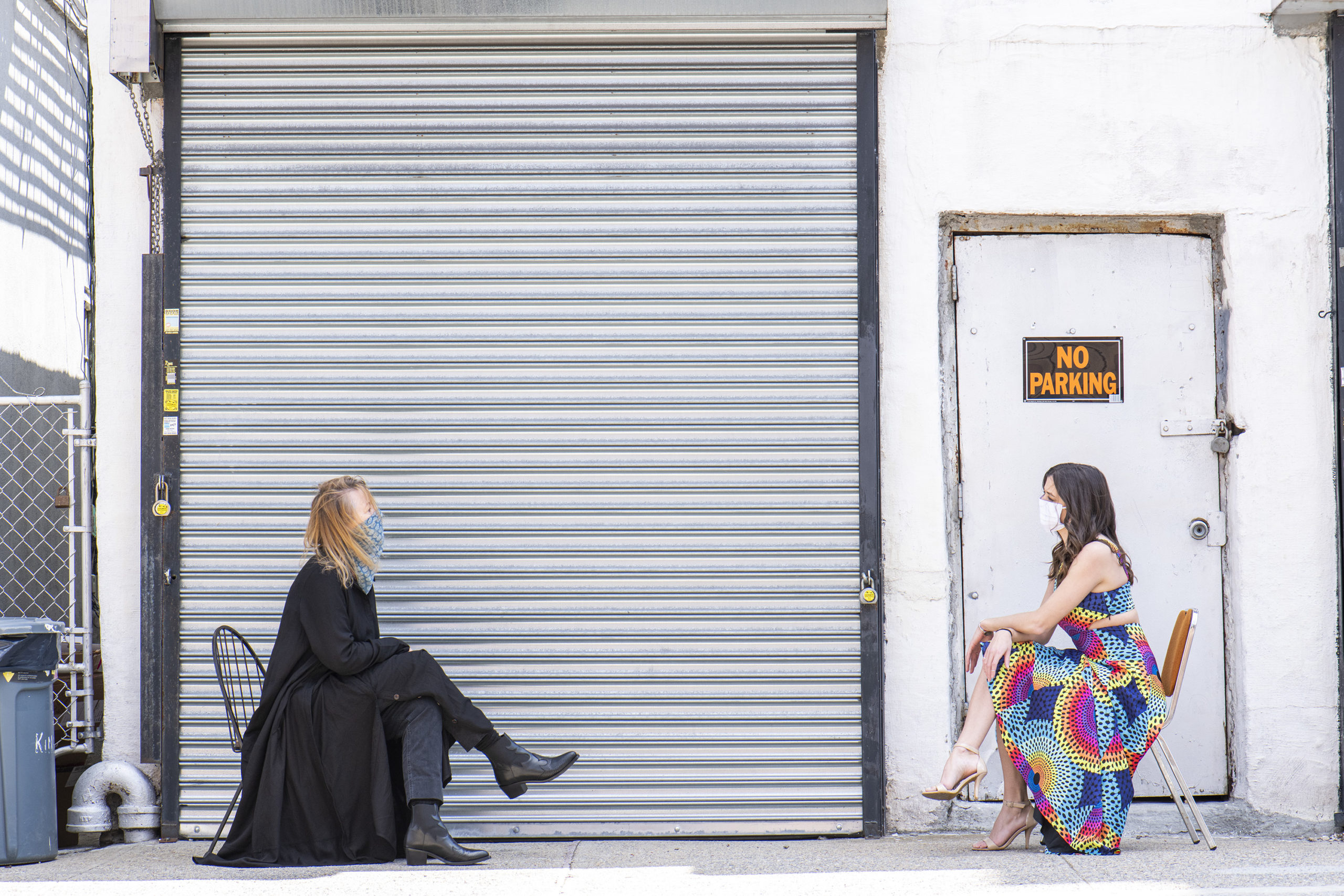
locked into circumstances
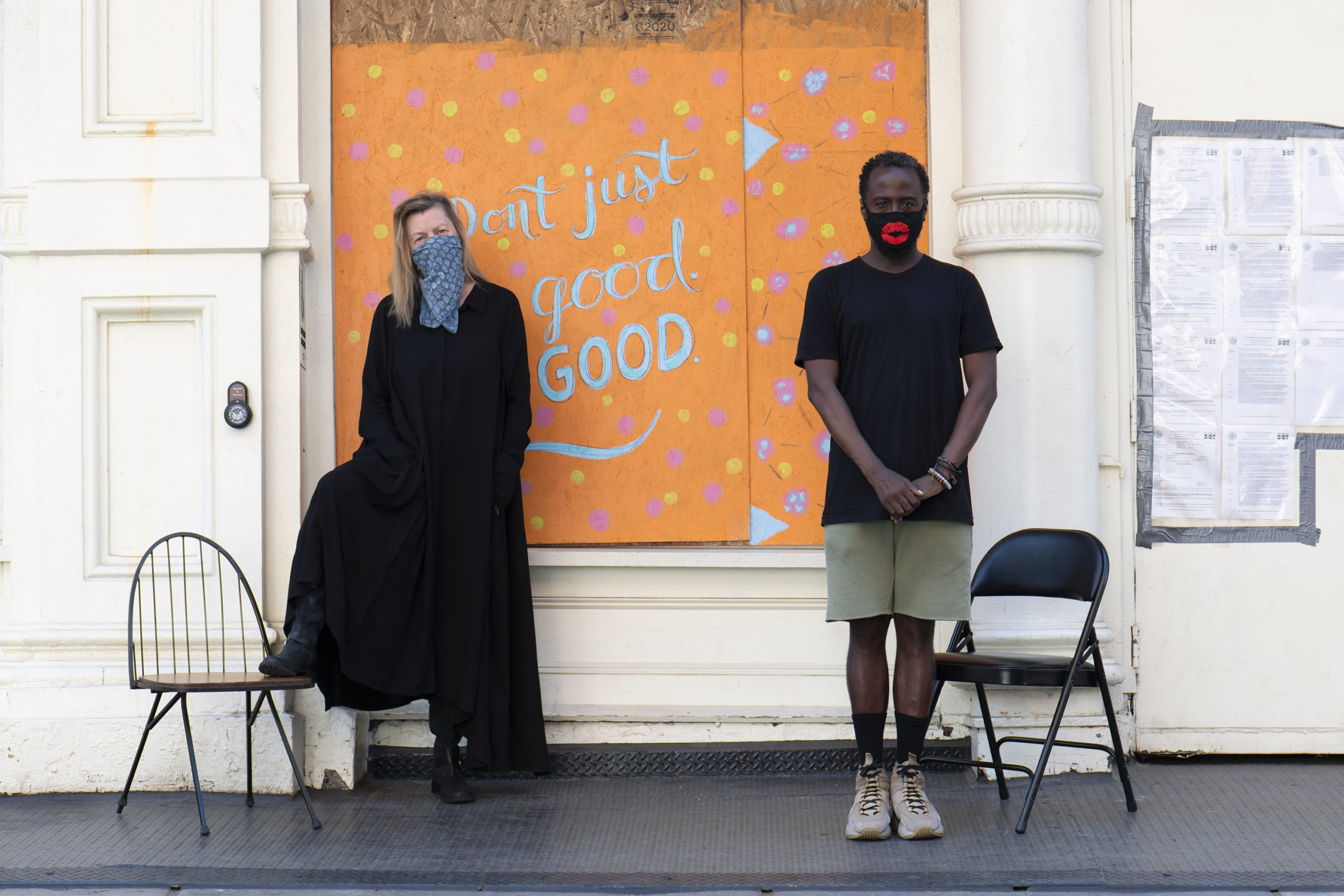


navigating the space between

These days I feel like time flows in slow
motion –
it allows my thoughts to anchor and stay
with a thought or a visual for much longer
and this stillness allows a change.
It is a time for our earth to heal itself,
people to respect each other — (with
distance), –reaching out without touching
and holding each other in their thoughts
without touching
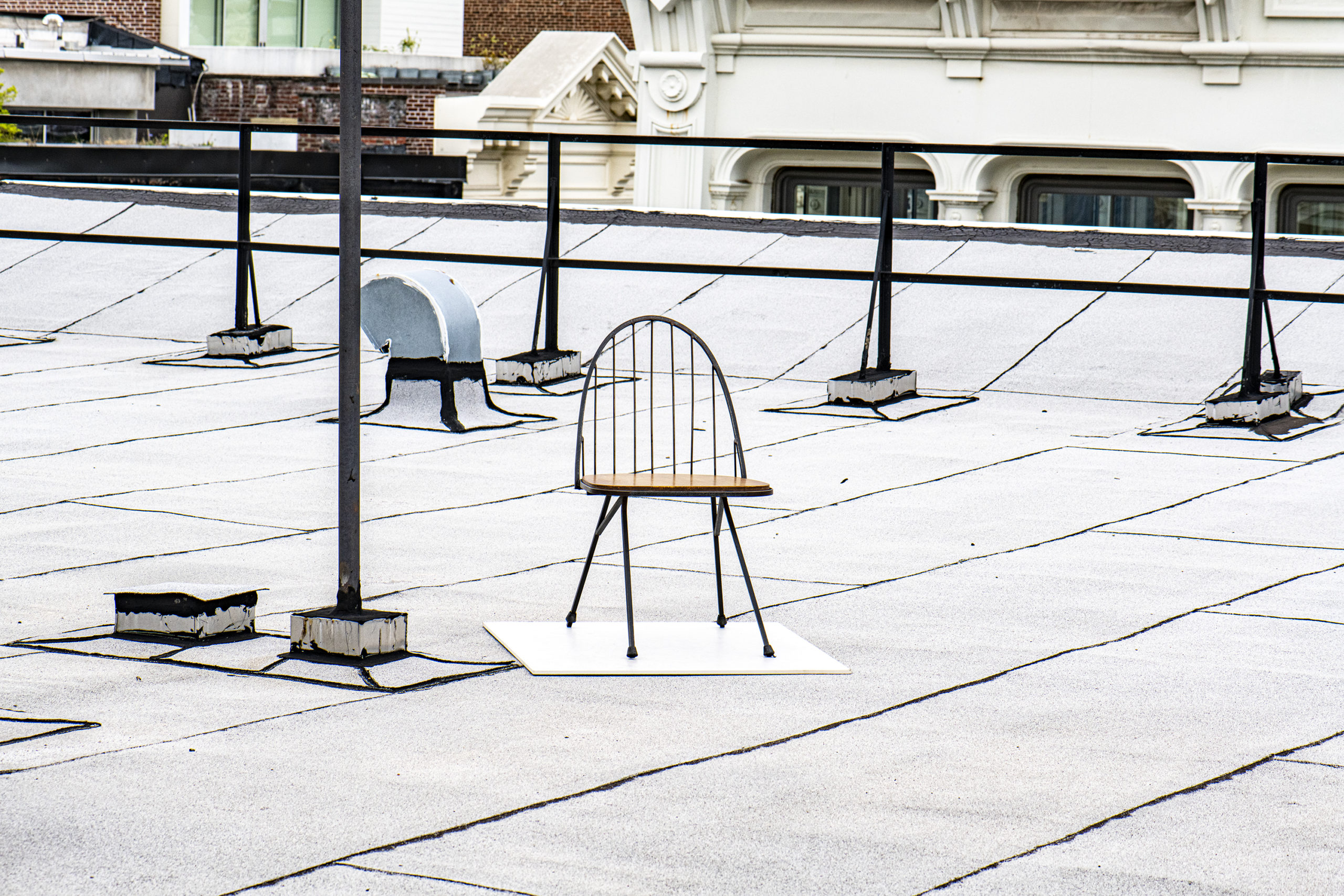
self-portraits with :
Dashielle Allen
Timothy Allen
Agnes Barley
Erica Baum
Christian Beckett
Max Blagg
Jill Brienza
Ruthie Byers
Jacob El Hannani
Elizabeth Fiore
Mary Fraser
Dan Frieber (Baby Boy)
Aimee Good
James Hall
Darius Himes
Jonas Hegewisch
Becky Jones
Maria Jost
Graham Leader
Alex Markwith
Lara Pan
Sabine Rumpl
Michael Scott
Paola Singer
Peter Stampfel
Donna Strugatz
Natasha Strugatz
Alison Wade
Johan Wahlstrom
Jil Weinstock
Elizabeth Wollheim
Samantha Wood
ESSAYS
“I Remember the Last Person I Hugged“1
by Marilyn Satin Kushner
Renate Aller is about communication. She is about relationships – both within nature and between people. She is about space and how that affects the human condition. Aller makes art and she is about life and art and how they interact.2
On Thursday, March 12, 2020, Renate Aller and her husband, Hugh, began quarantining in their loft apartment in the SoHo neighborhood of New York City. On March 20, 2020, Governor Andrew Cuomo ordered all non-essential businesses in New York to shut down due to Covid-19. New York City streets, once so electric and full of people, fell completely silent except for the piercing sound of ambulance sirens as patients, sick with the virus, were rushed to the hospitals. People were afraid to venture outside. Thriving businesses closed and everyone stayed home, quarantined, alone in their solitude.
Zoom became the way many came together, virtually. In the beginning it was comforting to be able to see loved ones and friends. But that digital “space” was not enough. Human contact becomes sterile when that coming together is on a screen. In April, Aller began inviting close friends to join her on the sidewalk in front of her building. She recalled that often this was the first contact that some had had with anyone for weeks.3 One of her intentions was to connect and these visits created a “deep sense of community where community has been forced apart.”4
Thus began her series side walk.5 Aller named this side walk rather than sidewalk because she “chose to write it as a verb and action rather than a noun. What happened on the sidewalk is that we ‘had to walk to the side,’ which suggests a bodily movement away from something or someone.” Aller was not just thinking about the physical sidewalk but rather a concept of space, moving around in a space, nurturing a relationship to space. She set up two chairs, six feet apart, as recommended, and insisted on mask wearing. There was no touching, no hugging. She remarked, “To be together in a physical space with other people is reassuring, a more intimate experience than a digital space.”6 Aller had created an emotional landscape.7 In all, she had 32 sittings. Some components of these sittings were always the same – her two chairs, her long black dress, the camera, the lens on the self-timer, and multiple exposures (usually nine) all three seconds apart in each encounter. “Most importantly,” she remarked, “my desire was to meet my friends and neighbors and sit still for a long time after the photos were taken and talk and talk and listen. This project is in the spirit of Rainer Maria Rilke ‘that each should guard over the solitude of the other . . . ’”8 It was caring, it was about patience, and it was about relationships.
And yet, Aller felt that side walk was also about solitude. Did quarantining in solitude lead to the side walk series? Or, was it because even when Aller was on the sidewalk with her friend, they were still apart, they could not get any closer to one another, not even for a hug? This is the same sidewalk that Aller has crossed so many times in her life. But now that space was completely transformed. It became filled with memories of togetherness and, at the same time, of solitude.
The masks created another boundary, a separation. They prevented the friends from reading emotions. Masks keep one safer but they also separate us – we are different from each other now; we do not belong in anyone else’s very private space and thus we cannot completely share the space we in which we find ourselves. We can no longer easily recognize each other’s emotions because, in our society, we are programmed to read the entire face and not just the eyes and forehead. Is she smiling, is he frowning, is he noncommittal, is she surprised?
We can be alone in solitude even when we are not completely alone, and that can be the most difficult type of solitude with which to grapple.
There came a point when Aller felt that she was ready to move on to the next step of side walk.9 She began to consider the book containing these photographs, understanding that a book is its own space but one that you could hold in your hand.10 And, books have their own rhythms. Aller quickly determined that each session would be represented by only one photograph in the book, and that there would be only one photograph per page. This protected the unique aspect of each encounter. She also resolved that she could bring these people together and create a new community within the isolation created by Covid-19. While space between the images in the book was a determining factor, there was also a factor that united Aller and the sitters with each other. The middle fold (or the gutter) created by binding the book and the placement of the photograph across the gutter had the effect of bringing these sitters together. Moving from one page to the next has a similar effect. The repetition of these pages became a performance in itself as one’s eye dances from one page to the next.
Aller once wrote that the aesthetics she grew up with “were those of the Bauhaus, without any distinction between design, craft and fine art, the socio-political values and their interconnectedness weaving together the texture of meaning.”11 According to this concept, born of Germany, anything can be considered art if that is the intention of the maker. This gives the artist license to create beyond the boundaries of a canvas, a sheet of paper, a cutting of stone, a piece of wood, or a mound of clay, a dance, an encounter, or a crowd. The possibilities are endless.
The concept of performance is well-known to Aller. As a teen in Hamburg , she presented a project in which she created sound spaces by “composing and performing music in combination with movement/dance.”12 Once, she arranged a performance on an island/median in the road. She invited some friends, and they had a rather nice meal together while the cars whizzed by. The car occupants had no idea that they were witnessing an art performance. That was ok – it was actually an integral part of the performance. Not long after, Aller decided that rather than attending art school in Germany, she would go to London where she was given an opportunity to mount an exhibition at Hamiltons Gallery. She presented a performance piece for the opening where six other friends sat down to a dinner in front of the guests at the opening. She had designed the table at which they were seated and the pictures on the walls of the gallery were hers as well. There was no contact between the diners and the invited guests at the opening, although this time the observers clearly knew that they were witnessing an art performance. These were the years (1980s and early 1990s) when multimedia works and performances, including her own, filled the galleries.
All of this was on the heels of the Fluxus movement which Aller often references in relation to her work.13 Although she was too young to partake in that movement, she finds an affinity with the Fluxus artists’ ideas of unrehearsed events in a public space. This was described by the Fluxus artists, and especially John Cage, as an art form for the people. So too is Aller’s work unrehearsed and has a much more direct relationship with the public, even if the viewers do not always know they are part of the performance.
One cannot help but see side walk as a continuation of Aller’s previous participatory works. But perhaps the best comparison is to look at it in light of Marina Abramović’s performance work, The Artist Is Present, at the Museum of Modern Art, New York, in 2010. Abramović sat across a table from a stranger, neither uttering a word but both staring into the soul of the other. The space around them was energized, as a crowd gathered around at a distance and watched. Aller’s and Abramović’s performances were ten years apart but so much further apart in the worlds we lived in then and the one that we live in now. Still, there is something similar in how each artist energized the space with another person, making that space special for the two of them: one encounter with words – another without them, one with previous connections – the other without that history, but both just being in that space and creating their own small world. They never touched but nevertheless created a connection.
Indeed, Aller stayed far away on her sidewalk and never touching her guests but, nevertheless, she was giving them a “hug” in so many intangible ways that we are all discovering are possible in these Covid-19 days.
__________________
1Aaron Katersky, Renate Aller Interview – ABC News: Celebrating the Arts with Aaron Katersky, November, 2020.
2For further information on Renate Aller see: renatealler.com
3Katersky, Renate Aller Interview.
4Chronology Renate Aller, December 27, 2020, inpaginated.
5Renate Aller, side walk for Marilyn, written interview, January 21, 2021, unpaginated.
6Aller, side walk for Marilyn.
7Katersky, Renate Aller Interview.
8Rainer Maria Rilke – In a letter to the trailblazing German expressionist painter Paula Modersohn-Becker, Rainer Maria Rilke (December 4, 1875–December 29, 1926) offered some spectacular advice on managing the bipolar pull of autonomy and togetherness in a way that assures the longevity of any close bond and protects love from self-destruction
the passages appear in the poetry and prose anthology Rilke on Love and Other Difficulties: Translations and Considerations(public library), selected and translated by the scholar and philosopher John Mood.
Rilke on Love and Other Difficulties: Translations and Considerations Paperback – February 17, 1994
9This need to go to the next stage was partially influence by the fact that Aller felt compelled to photograph the Black Lives Matter protests which began in New York City in late May 2020. By early June the protests led to fires and looting in SoHo, Aller’s neighborhood. Stores were boarded up. Street murals were painted on the boarded-up stores. People were in the streets daily and into the evenings. Aller’s sidewalk was no longer a place of refuge. Renate Aller conversation with the author, January 16, 2021.
10Author’s conversation with Renate Aller.
11Chronology Renate Aller.
12Chronology Renate Aller.
13Renate and Hugh Aller’s studio and home, lies in a straight line between two Fluxhouses in Soho, 16-18 Greene Street and 81 Wooster Street. For further information on Fluxus see Barbara Haskell, Blam, The Explosion of Pop, Minimalism, and Preformance 1958–1964, exh. cat. (New York and London: Whitney Museum of American Art in association with W. W. Norton and Company, 1984).
The Life of Others
Lara Pan
Action is happening in front of the doors of 33 Greene Street in Soho and other neighborhoods in New York City. We can call it the soul of NYC during the global Covid-19 pandemic. The ongoing social distancing measures show the seriousness of the pandemic, and so do the masks we’re wearing. They’ve become an inseparable part of our faces, able to hide our feelings and make us hard to recognize.
Renate Aller made a choice to interact with the pandemic landscape. She invited different actors with different origins, backgrounds, and professions to be a part of the project — whether close friends or next door neighbors. However, these images have the impressive ability to break our daily routine and affect the viewer through their straightforwardness.
What we’re seeing are images of people interacting with each other. Aller’s camera captures a state of being, hidden emotions of individuals wearing masks and their peculiar differences. The artist is interacting with a subject of choice and the subject is interacting with the artist eye of the camera.
Somehow every photograph in this series captures a moment in time of a “naked truth”. Even if their faces are hidden, body language and eye contact with a subject or the camera reveals fragility and the true essence of the individual’s state of being. What we experience is an unmediated outlook on the world, or something akin to full transparency in the time of the virus.
The “side walk” project reflects how we deal with isolation and how that will affect our communication with each other in the near future. How we will understand the space and energy between us while we have been spending most of our year hiding either behind masks or behind our computers? We live in strange times, or as Kim Stanley Robinson described the paradox for us: “It’s eye to eye, this knowledge that, although we are practicing social distancing as we need to, we want to be social — we not only want to be social, we‘ve got to be social, if we are to survive. It’s a new feeling, this alienation and solidarity at once.”
As humans, we are simply not prepared to live in vast data-scapes, to roam the dark forest of the internet, or be faced on a daily basis with the question of: is what we are seeing true or just more incorrect information in another fake news story?
These photographs tell us secret stories of people living in unnatural conditions due to the global pandemic. Some of them are dealing with imposed isolation alone, some with animal companions, and some with families or friends.
Renate Aller sources her “side walk” project from literatureand poetry. Quoting the beautiful phrase from Rainer Maria Rilke: “… each should stand guard in the solitude of the other.” It is almost like the idea of a beautiful Buddhist mantra, which states that the most precious gift you can give to one you love is your true presence. This mantra is very simple: “Dear one, I am here for you.” And yes, this is a gift of true and simple presence that the artist is offering to us. She creates a view of togetherness that insists on more empathy and solidarity between us.
The beautiful part of this project is that it has captured prolonged eye contact in the city streets of Soho. “side walk” reminds us of the soul of New York from the past, and at the same time confronts the uncertain present and embraces the unknown future. Aller’s work narrates the passing of time and the ability to connect human souls and truly leave a trace in time.
Somehow these photographs move us in their silent vulnerability. Looking at them, I remembered a movie, “The Lives of Others” (2006), which talks about the isolation and fear established by the Stasi surveillance apparatus in East Berlin. This beautiful film, which deals with a political crisis and the factor of isolation and alienation of individuals, mirrors perfectly the similar condition of a pandemic crisis. Nowadays, the powerful images of Aller’s opus “side walk” are thematizing those factors and offering a glimpse of hope for a better future.
Born in Germany, Renate Aller lives and works in New York. Her work is in the collections of corporate institutions, private collectors, and museums, including Lannan Foundation, Santa Fe, NM, National Gallery of Art, Washington, DC, Yale University Art Gallery, CT, George Eastman House, Rochester, NY, New Britain Museum of American Art, CT, Hamburger Kunsthalle, Hamburg, Germany, Chazen Museum of Art, Madison, WI, Musée des beaux-arts Le Locle, Switzerland, Parrish Art Museum, Watermill, NY, and the New-York Historical Society Museum, NY, where the project side walk 6’ apart, NYC will be exhibited in March 2022.
Lara Pan is a New York based curator and writer. She was the Program and Development Director at White Box, NYC, from 2016–2020.Pan co-curated 2019 a solo exhibition of Carolee Schneemann’s “From Then and Beyond” at Kunsthalle Winterthur, Switzerland and 2020 with Tony Oursler, Match Gallery and MGML Museum, Slovenia. Past museum exhibitions include “The Wizard’s Chamber” Kunsthalle Winterthur (2013, Switzerland), Torre at the Peggy Guggenheim Collection, Venice Biennale (2009, Venice) and “When The Fairy Tale Never Ends”, Ford Art Project (2011, New York, NY)
Marilyn S. Kushner is the Curator and Head, Department of Prints, Photographs and Architectural Collections at the New-York Historical Society since 2006. She holds a Ph.D. in Art History from Northwestern University and has previously worked at the Whitney Museum as a Research Assistant, the Montclair Art Museum where she was Curator of Collections, and the Brooklyn Museum where she was Chair of the Department of Prints, Drawings and Photographs.
